This document provides an overview of using OpenCL to develop signal processing algorithms for an FPGA. It first introduces OpenCL and discusses its memory model and programming model, including host and kernel programming. It then discusses using OpenCL specifically for FPGAs and describes implementing some example algorithms like vector addition, N-point DFT and 8-point FFT using Vivado HLS. The document also discusses problems encountered and future work, and provides results and conclusions from implementing the algorithms on the FPGA using OpenCL.
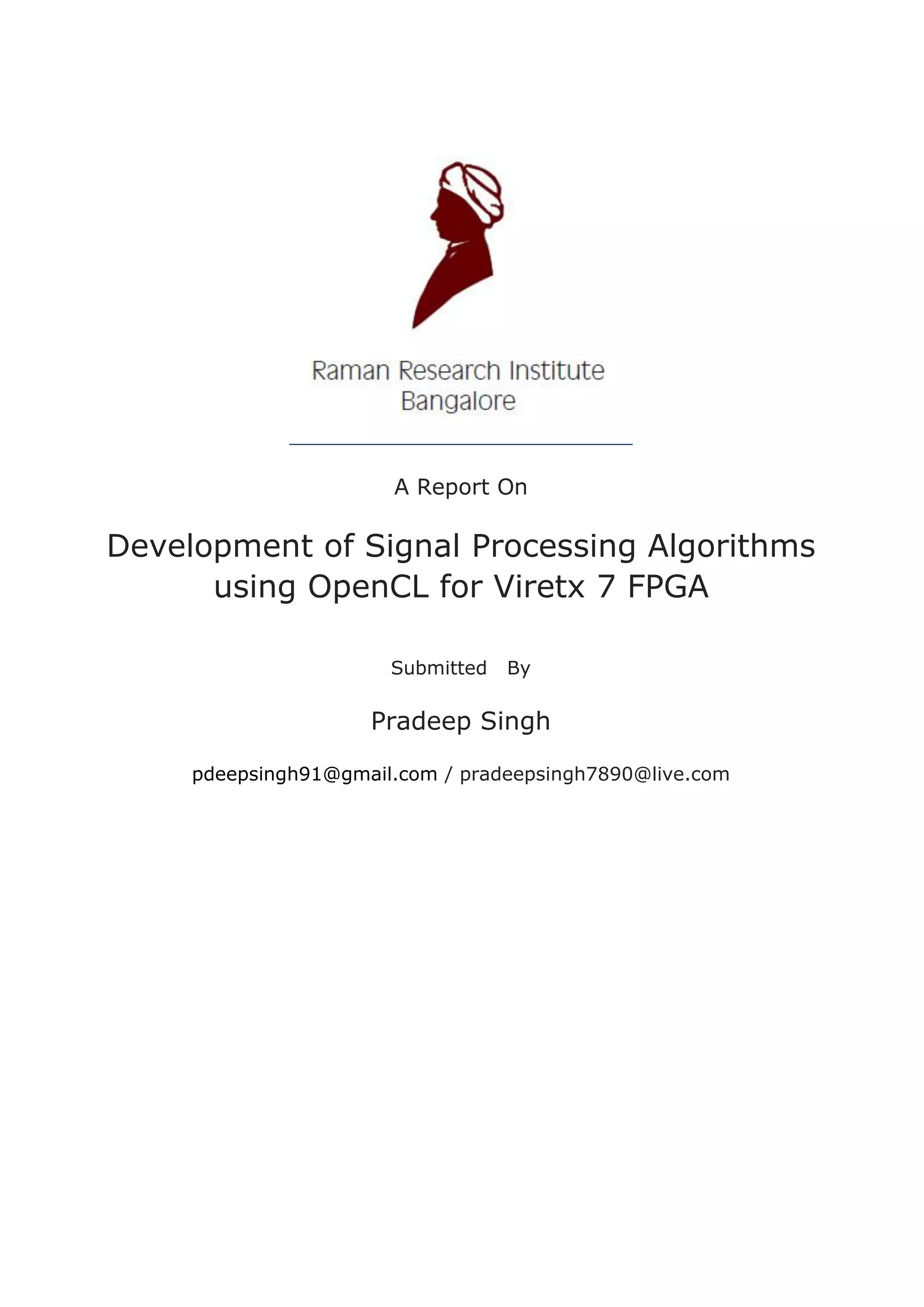
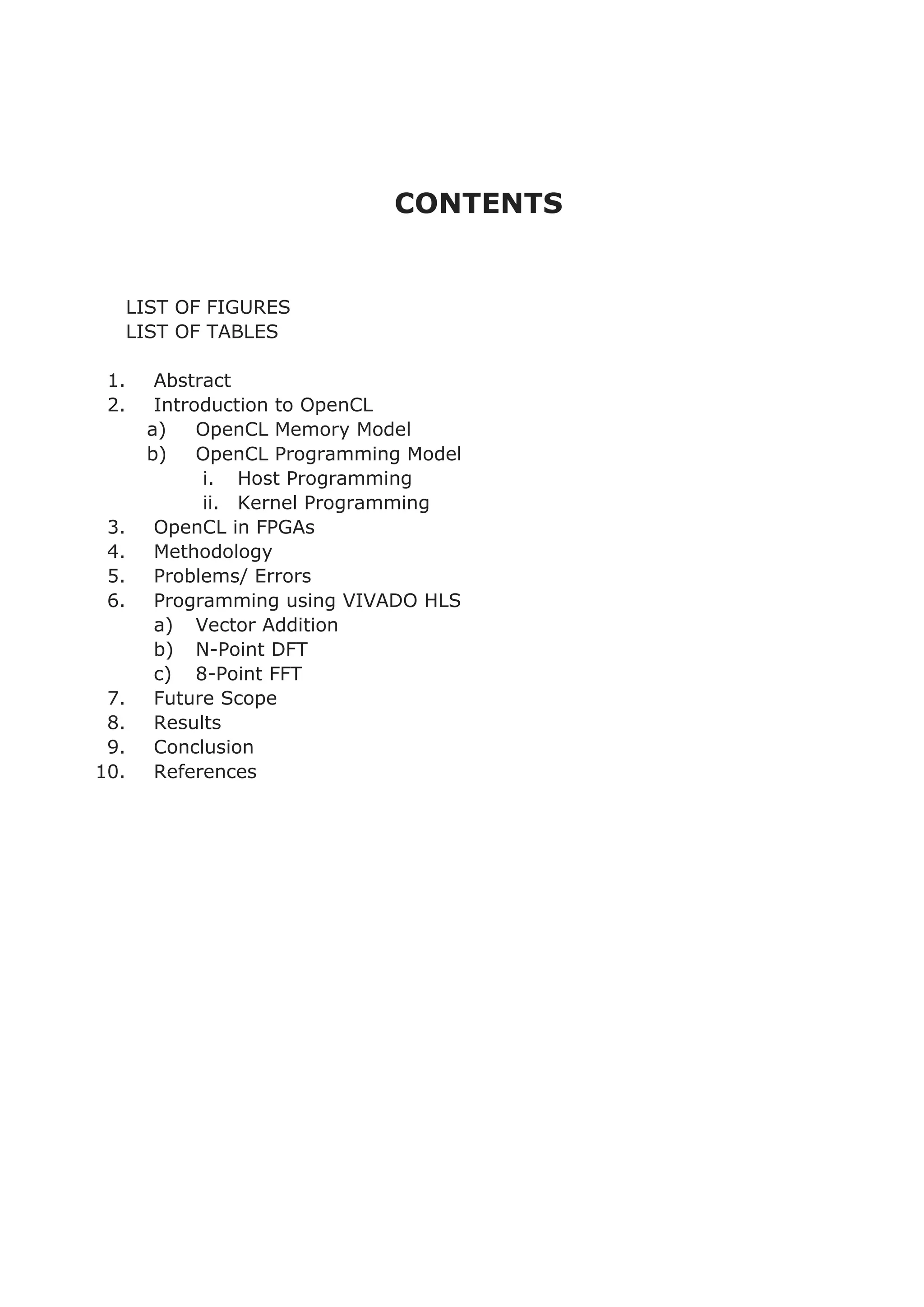
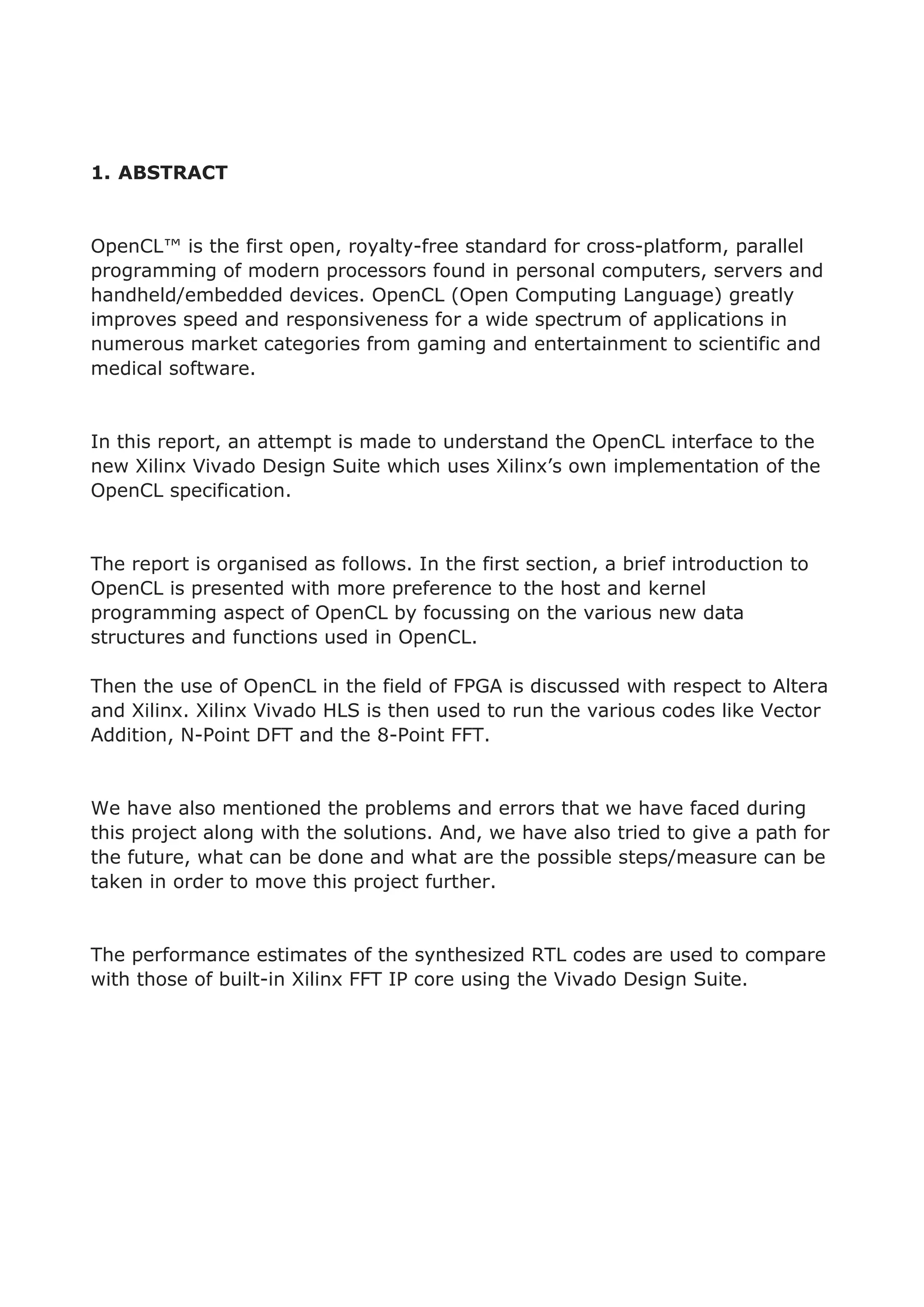
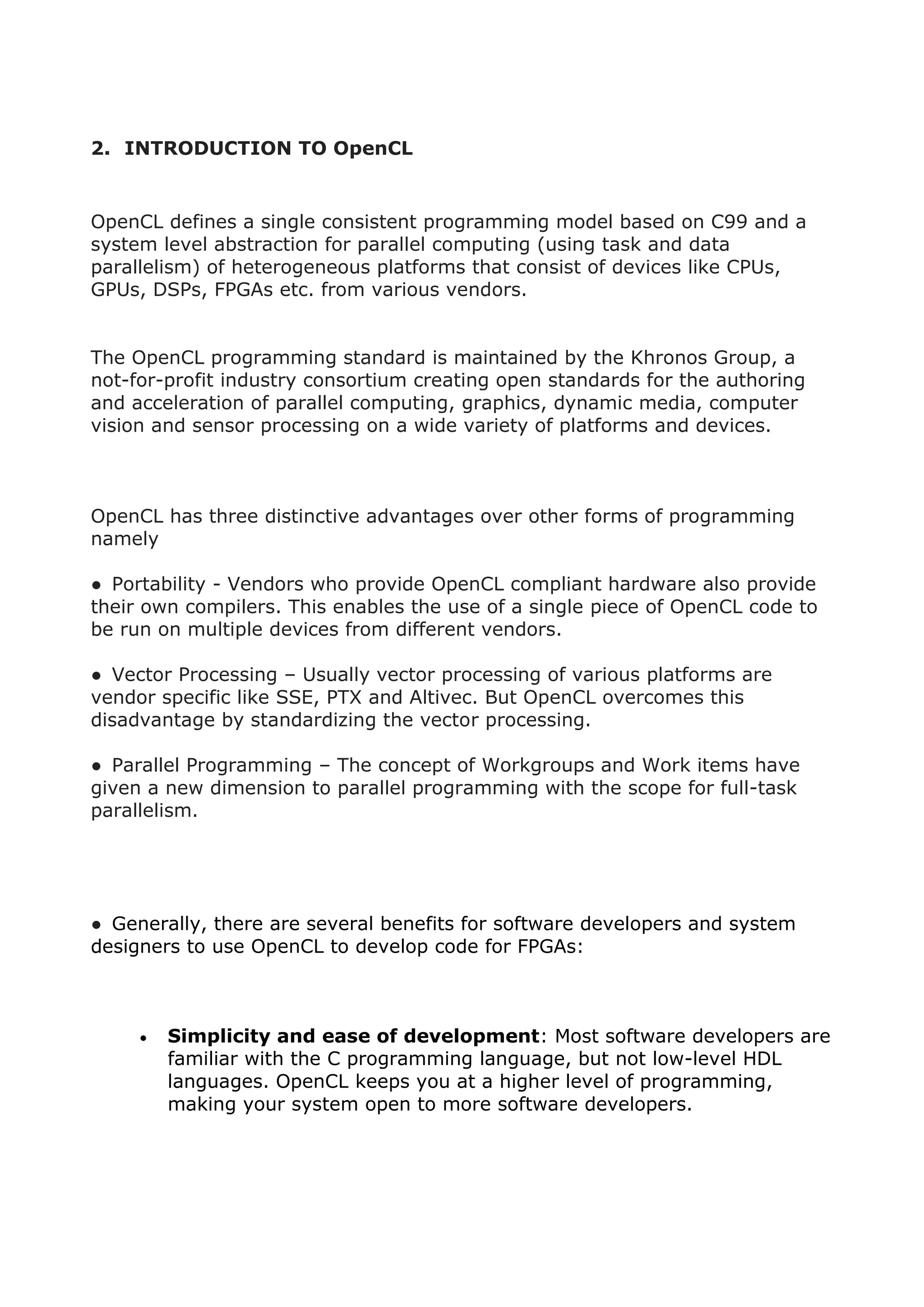
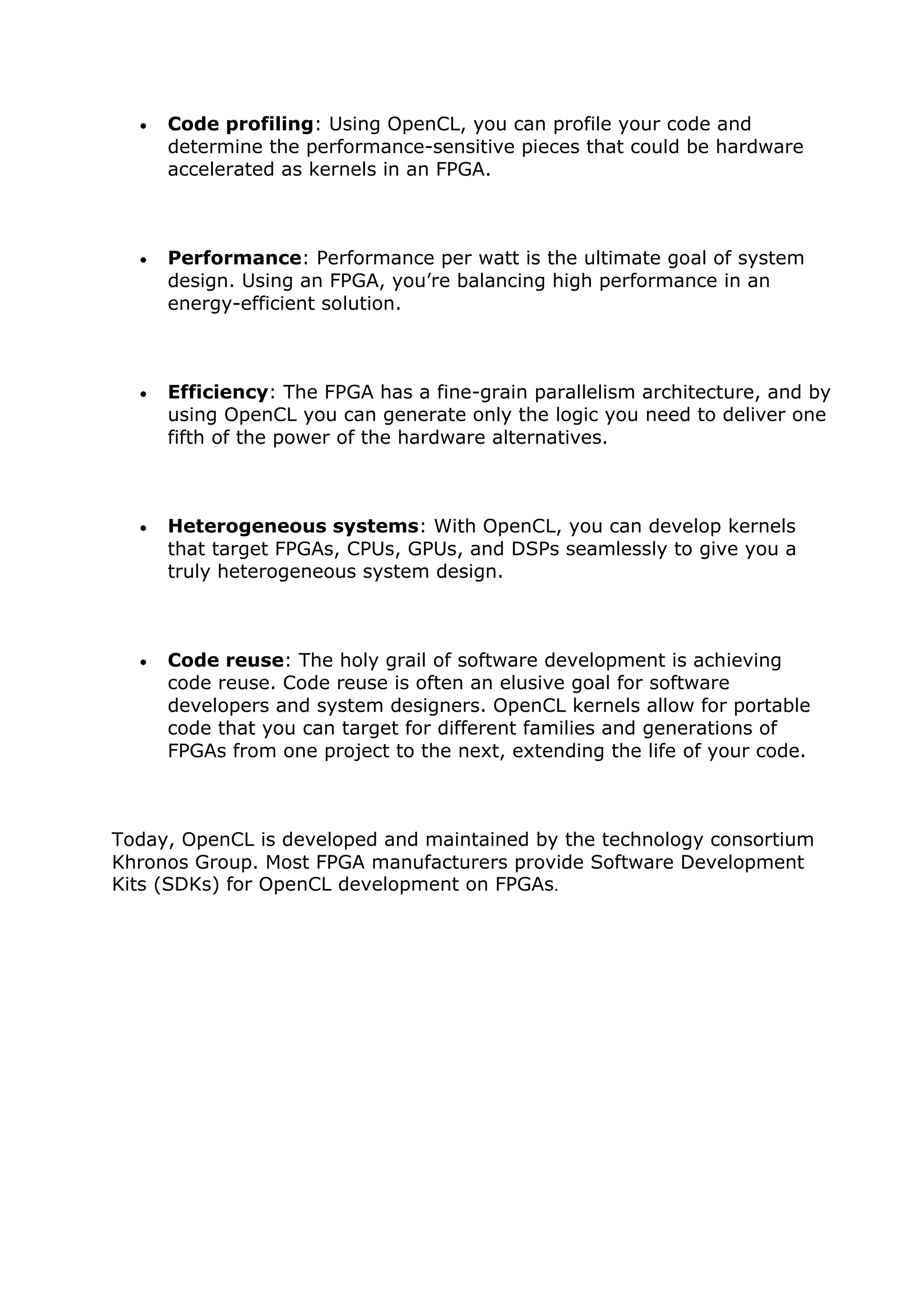
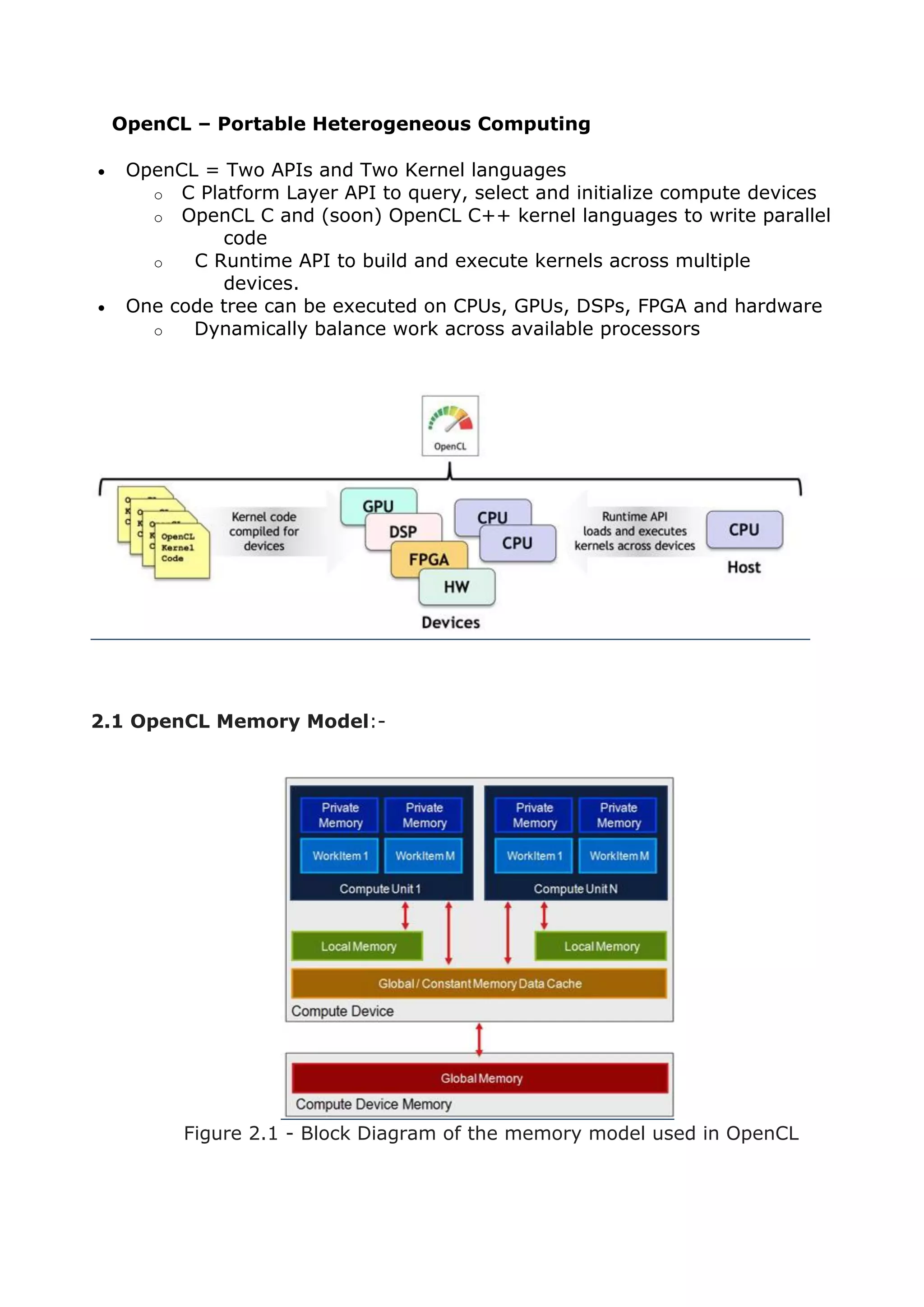

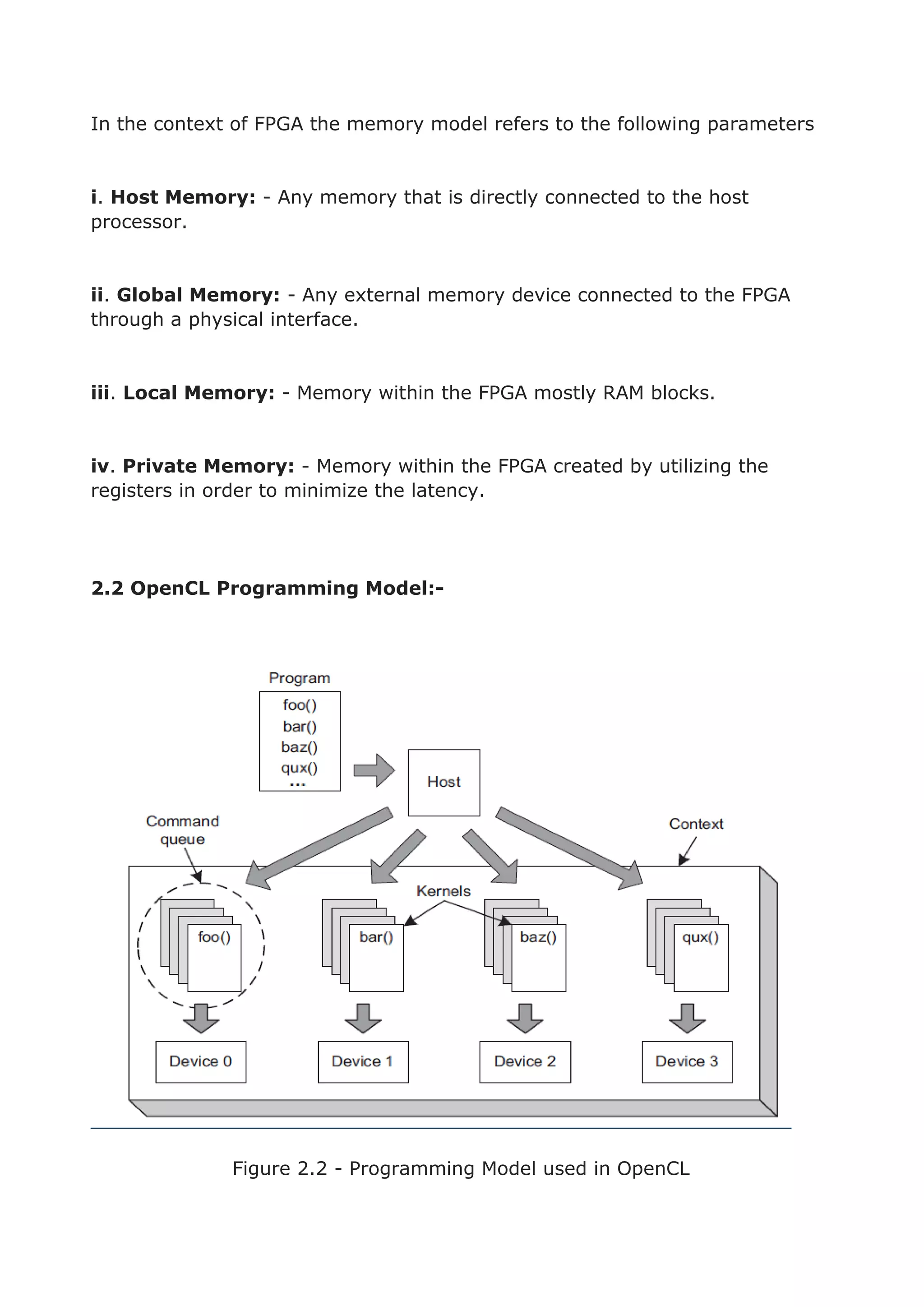

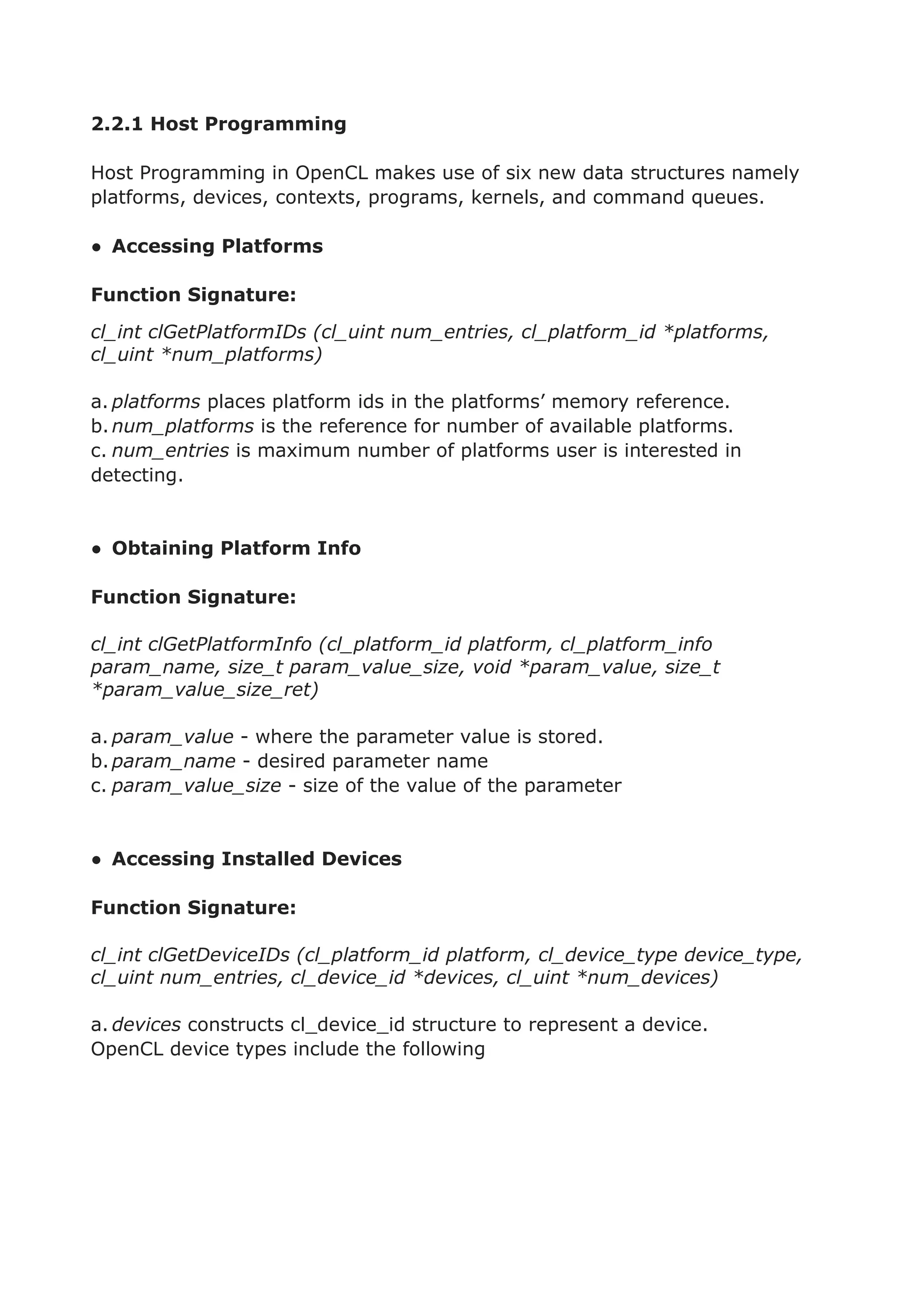
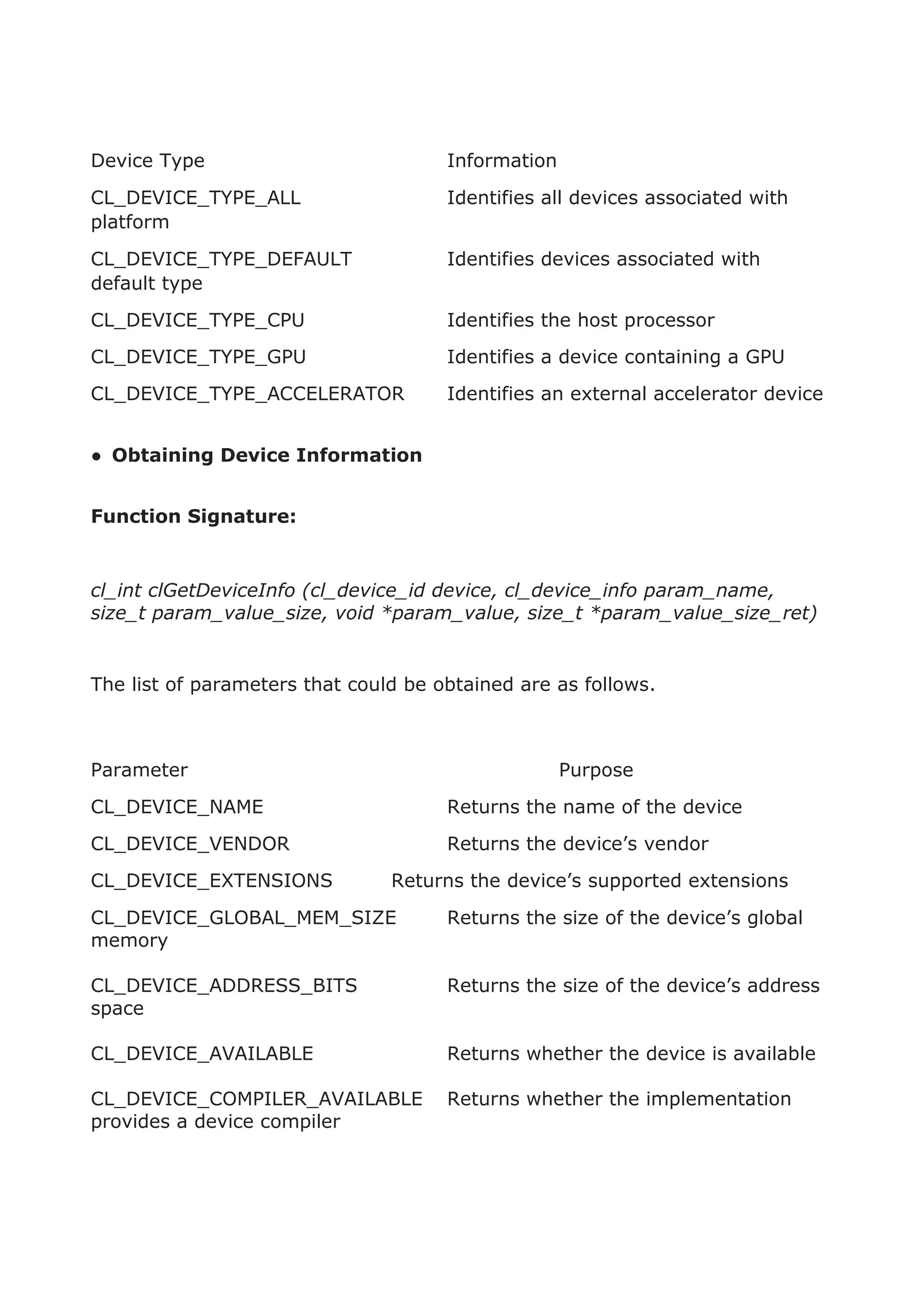

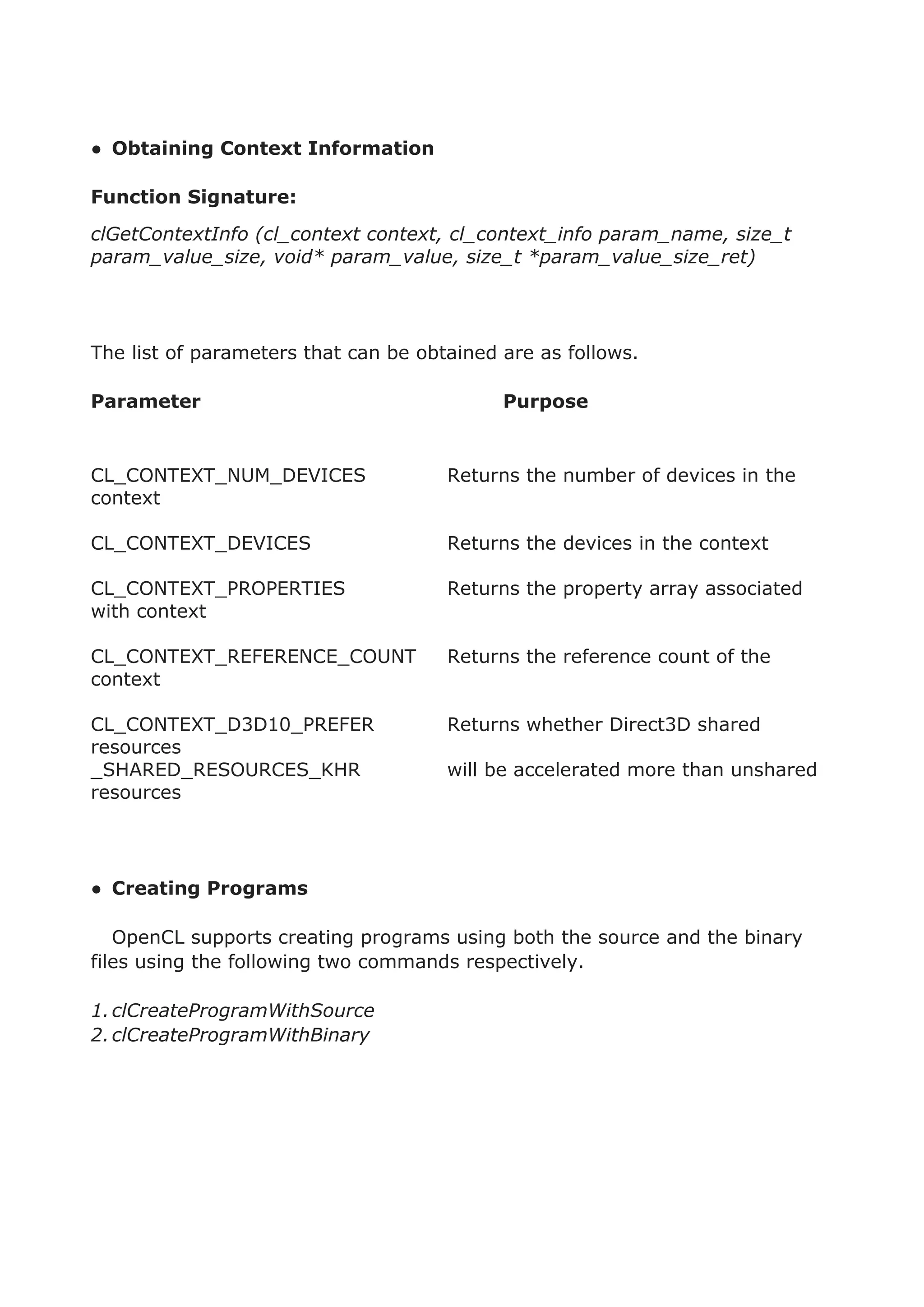

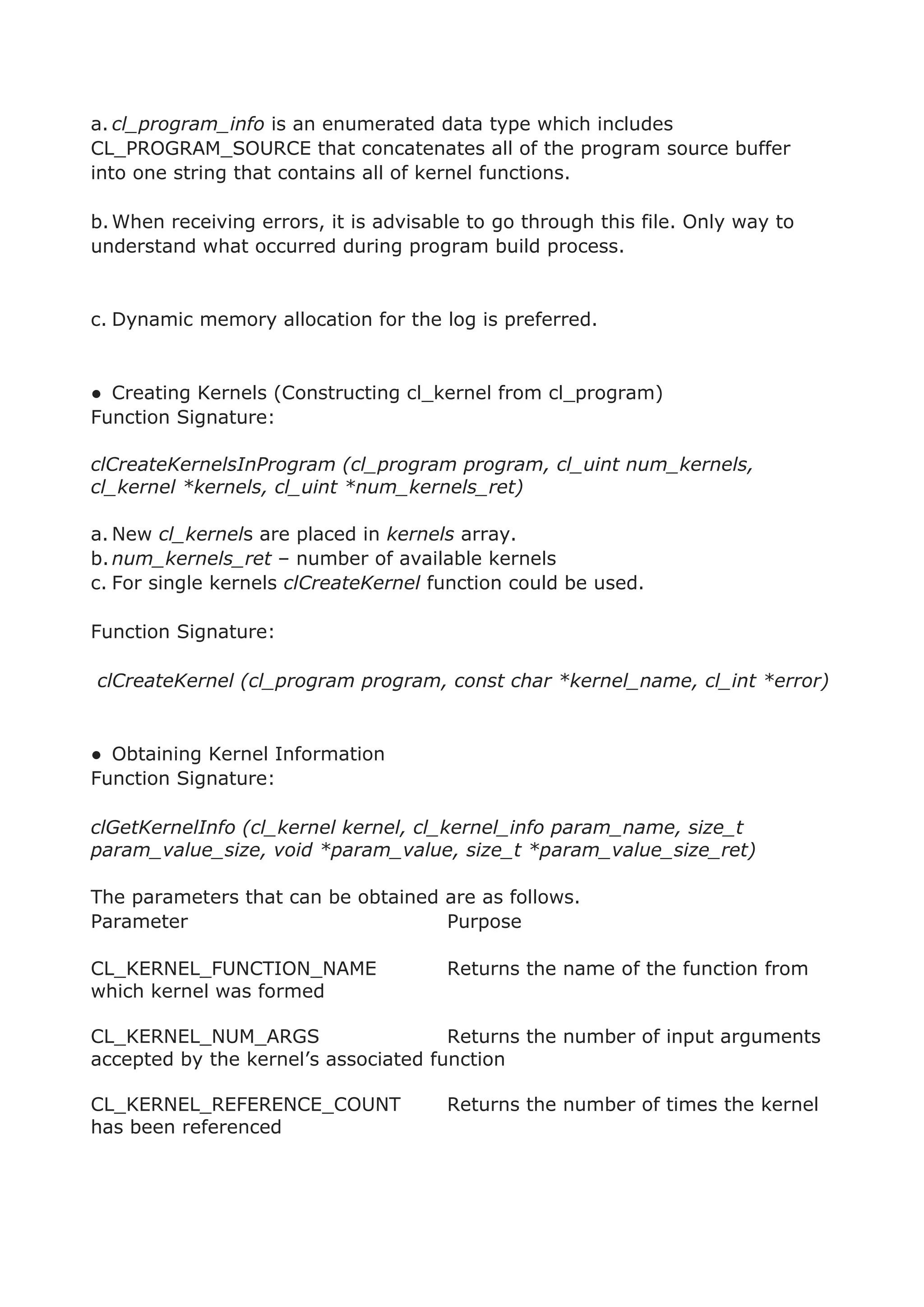
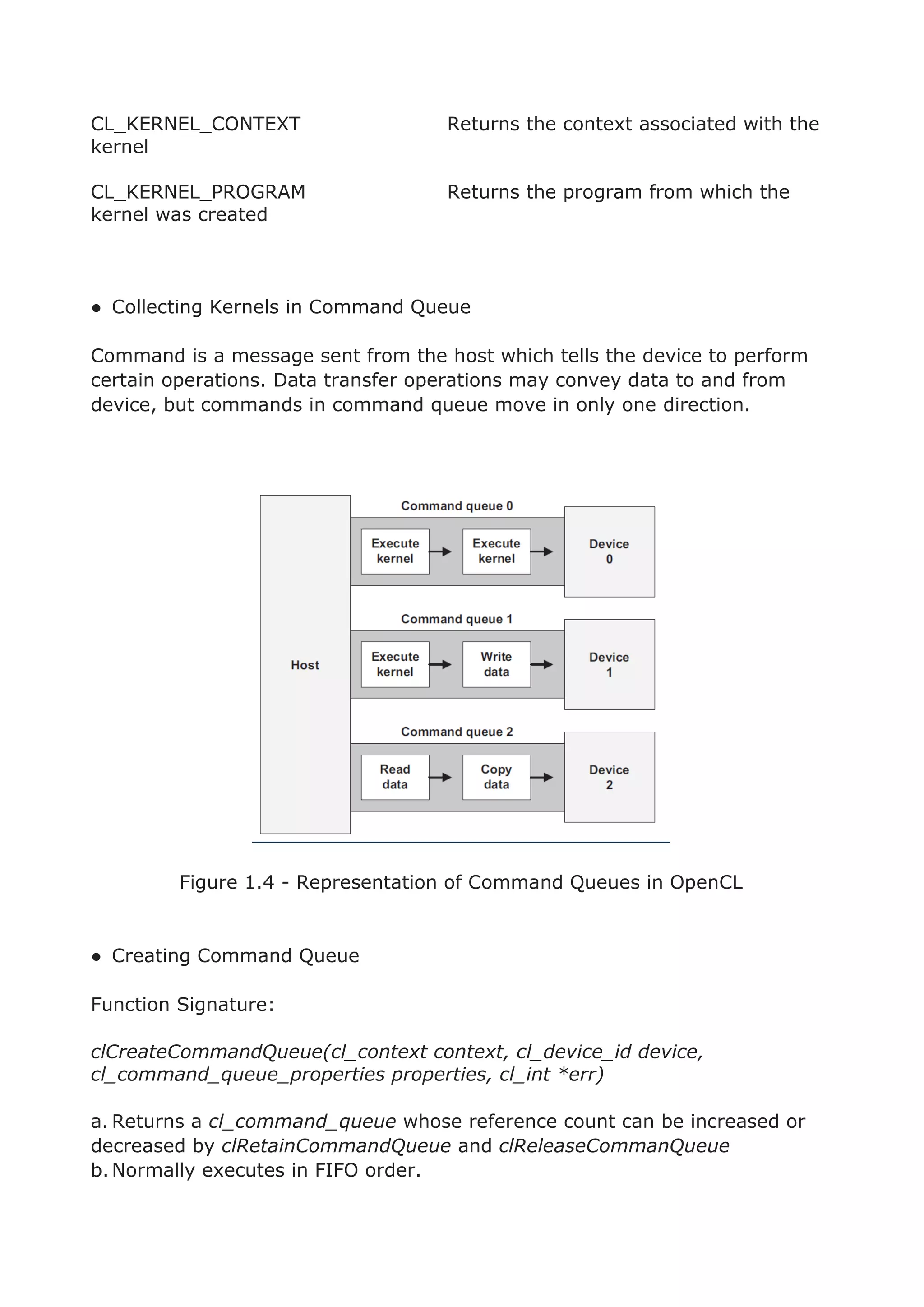
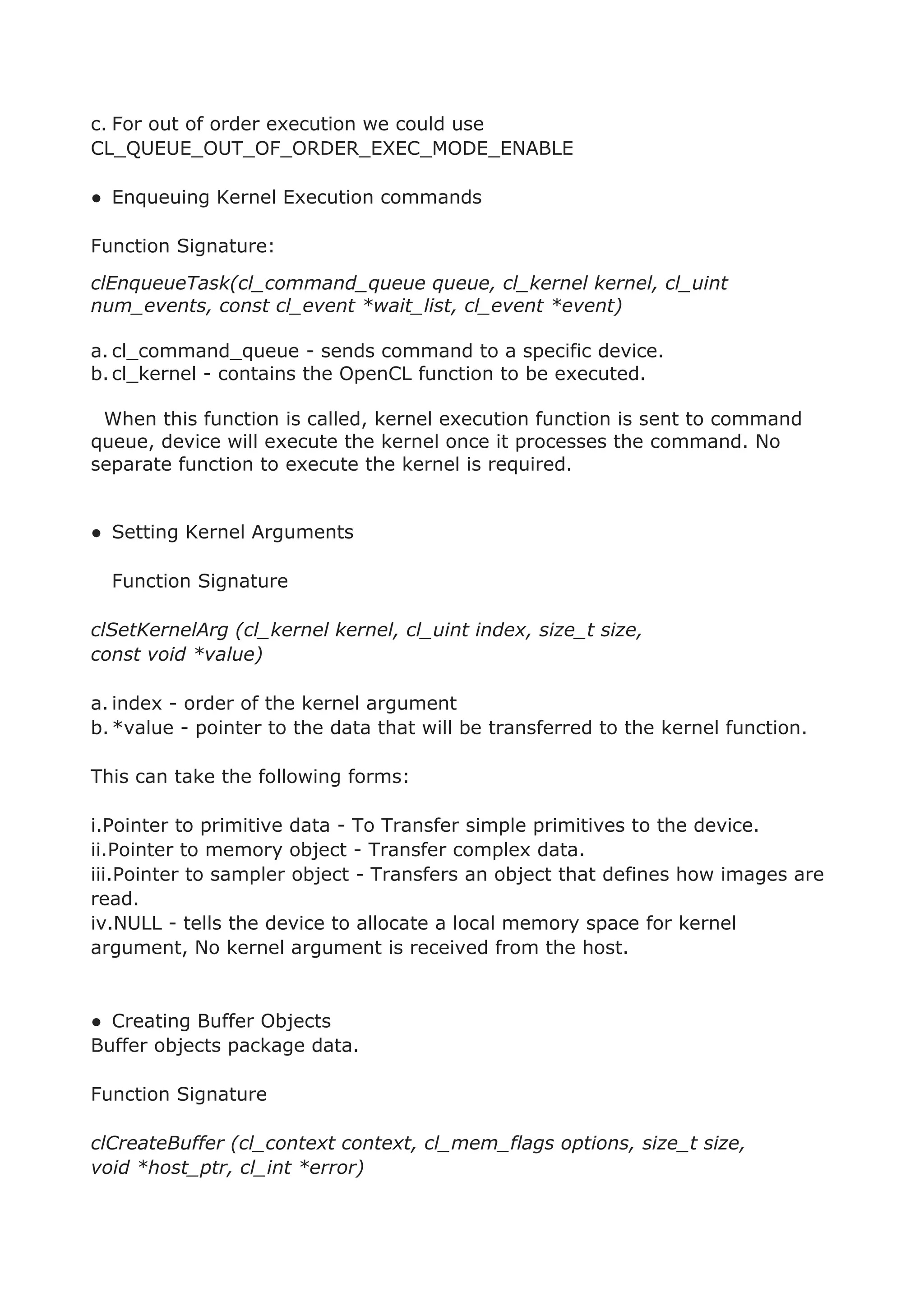

![size_t data_size, void *ptr, cl_uint
num_events,
const cl_event *wait_list, cl_event
*event)
clEnqueueWriteBuffer(cl_comman
d_queue_queue,
cl_mem buffer, cl_bool blocking,
size_t offset,
size_t data_size, const void *ptr,
cl_uint num_events, const
cl_event *wait_list,
cl_event *event)
Writes data from host
memory to a buffer
object
clEnqueueReadImage(cl_comman
d_queue queue,
cl_mem image, cl_bool blocking,
const size_t origin[3], const size_t
region[3],
size_t row_pitch, size_t
slice_pitch,
void *ptr, cl_uint num_events,
const cl_event *wait_list, cl_event
*event)
Reads data from an
image object to host
memory
clEnqueueWriteImage(cl_comman
d_queue queue,
cl_mem image, cl_bool blocking,
const size_t origin[3], const size_t
region[3],
size_t row_pitch, size_t
slice_pitch,
const void * ptr, cl_uint
num_events,
const cl_event *event_wait_list,
cl_event *event)
Writes data from host
memory to an image
object](https://image.slidesharecdn.com/c17fc98e-a864-4968-afb2-730eef728a11-160114020948/75/Development-of-Signal-Processing-Algorithms-using-OpenCL-for-FPGA-based-Architecture-19-2048.jpg)
![clEnqueueReadBufferRect(cl_com
mand_queue_queue,
cl_mem buffer, cl_bool blocking,
const size_t buffer_origin[3],
const size_t host_origin[3],
const size_t region[3], size_t
buffer_row_pitch,
size_t buffer_slice_pitch, size_t
host_row_pitch,
size_t host_slice_pitch, void *ptr,
cl_uint num_events, const
cl_event *wait_list,
cl_event *event)
Reads a rectangular portion
of data from a buffer
object to host memory
clEnqueueWriteBufferRect(cl_com
mand_queue queue,
cl_mem buffer, cl_bool blocking,
const size_t buffer_origin[3],
const size_t host_origin[3],
const size_t region[3], size_t
buffer_row_pitch,
size_t buffer_slice_pitch, size_t
host_row_pitch,
size_t host_slice_pitch, void *ptr,
cl_uint num_events, const
cl_event *wait_list,
cl_event *event)
Writes a rectangular portion
of data from host
memory to a buffer
object
● Mapping Memory Objects
Instead of using the read/write operations presented earlier, we can map a
memory object on a device to a memory region on the host. Once this map is
established, we can read or modify the memory object on the host using
pointers or other memory operations.
Commands such as clEnqueueMapBuffer, clEnqueueMapImage help on this
regard.
● Data Partitioning
Enables better distribution of processing load on various computing devices.
Function Signature](https://image.slidesharecdn.com/c17fc98e-a864-4968-afb2-730eef728a11-160114020948/75/Development-of-Signal-Processing-Algorithms-using-OpenCL-for-FPGA-based-Architecture-20-2048.jpg)
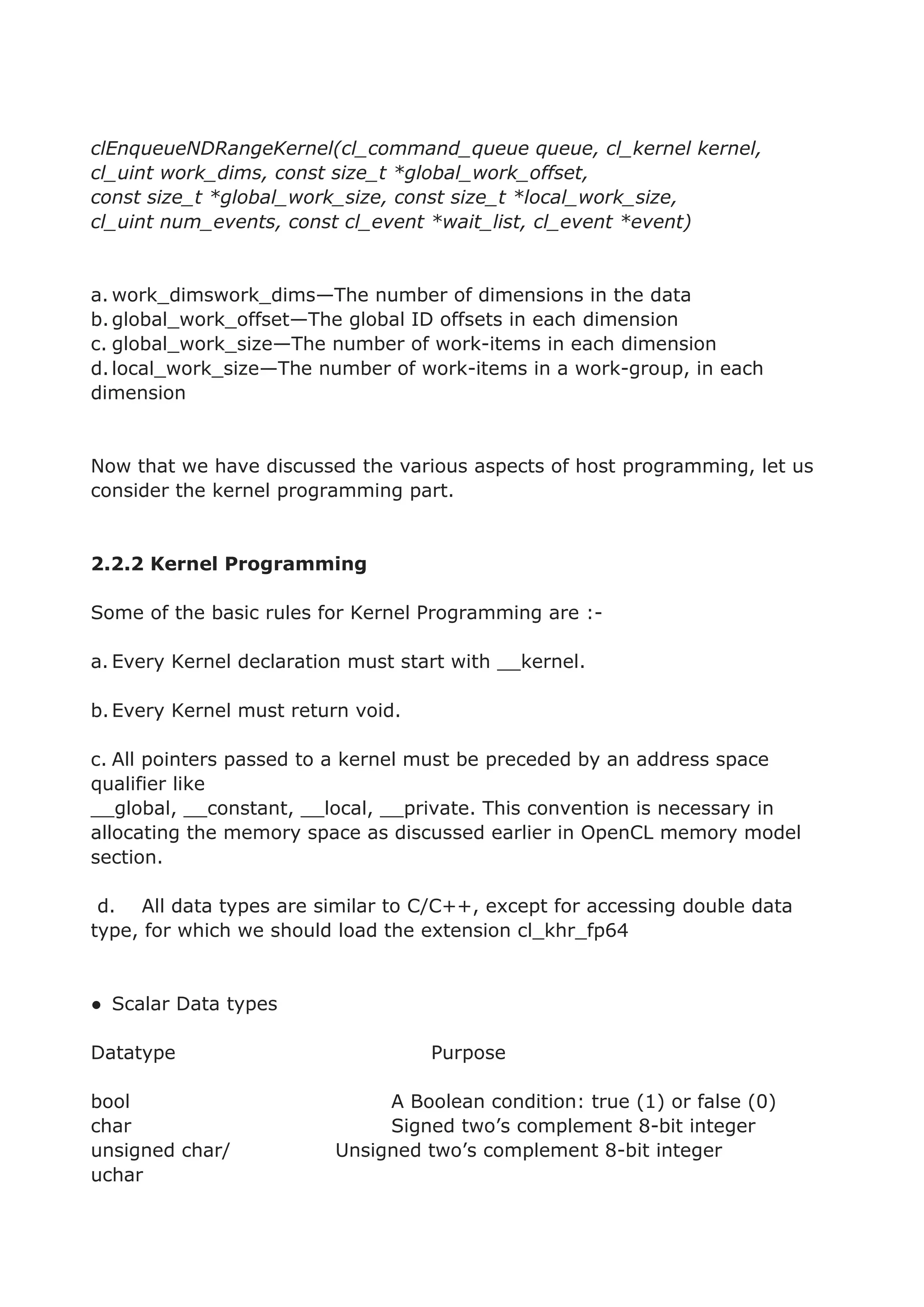
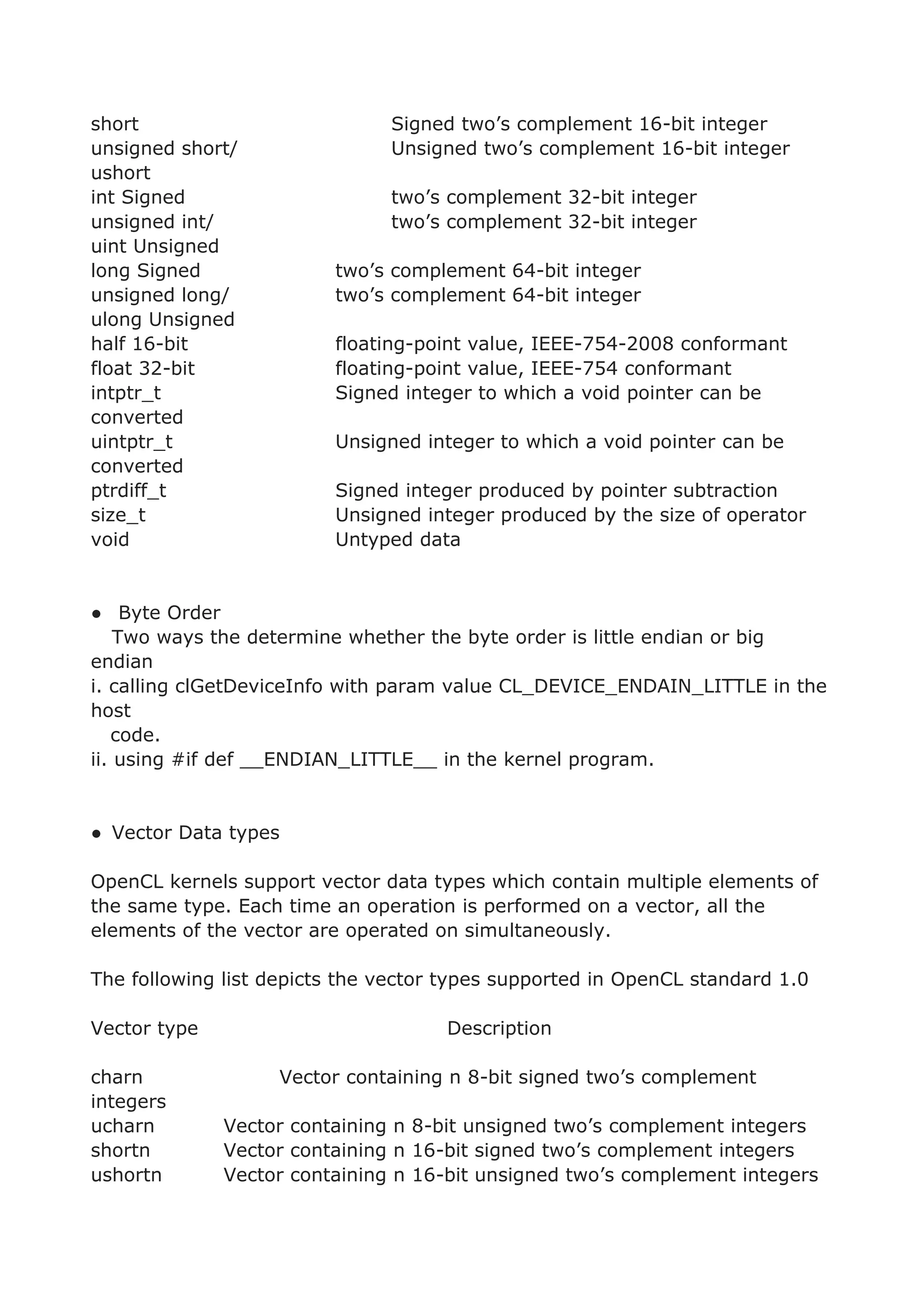
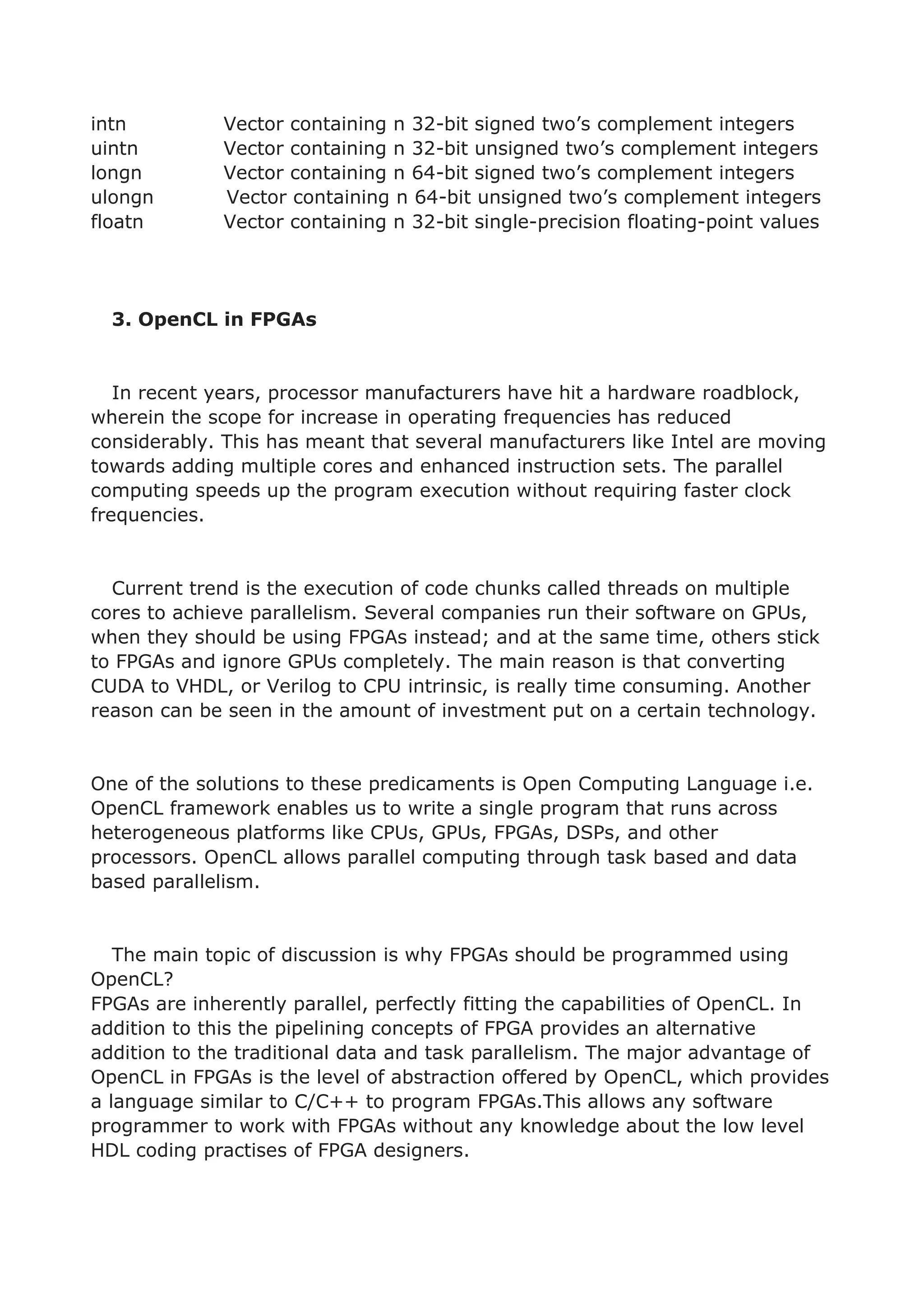
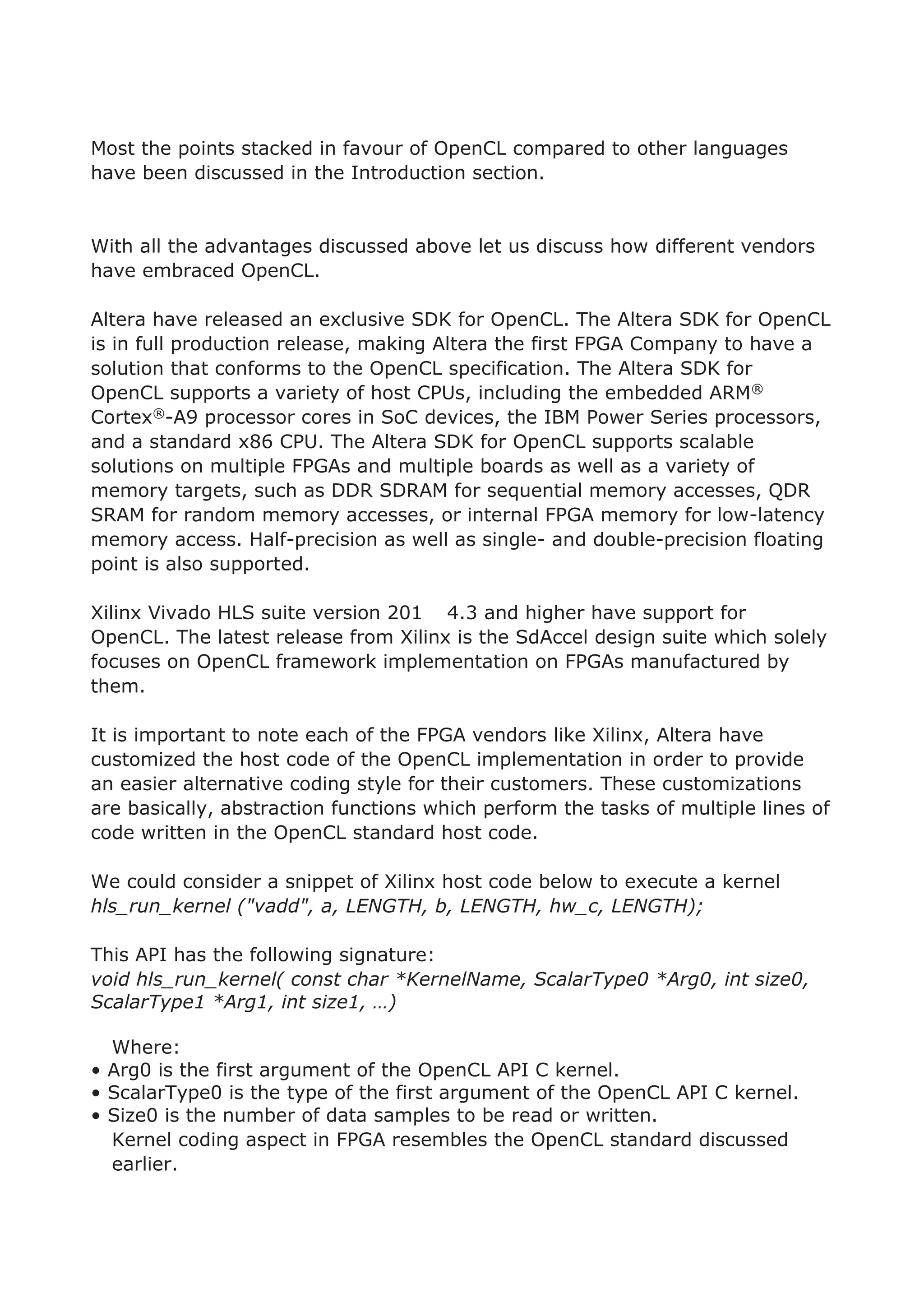
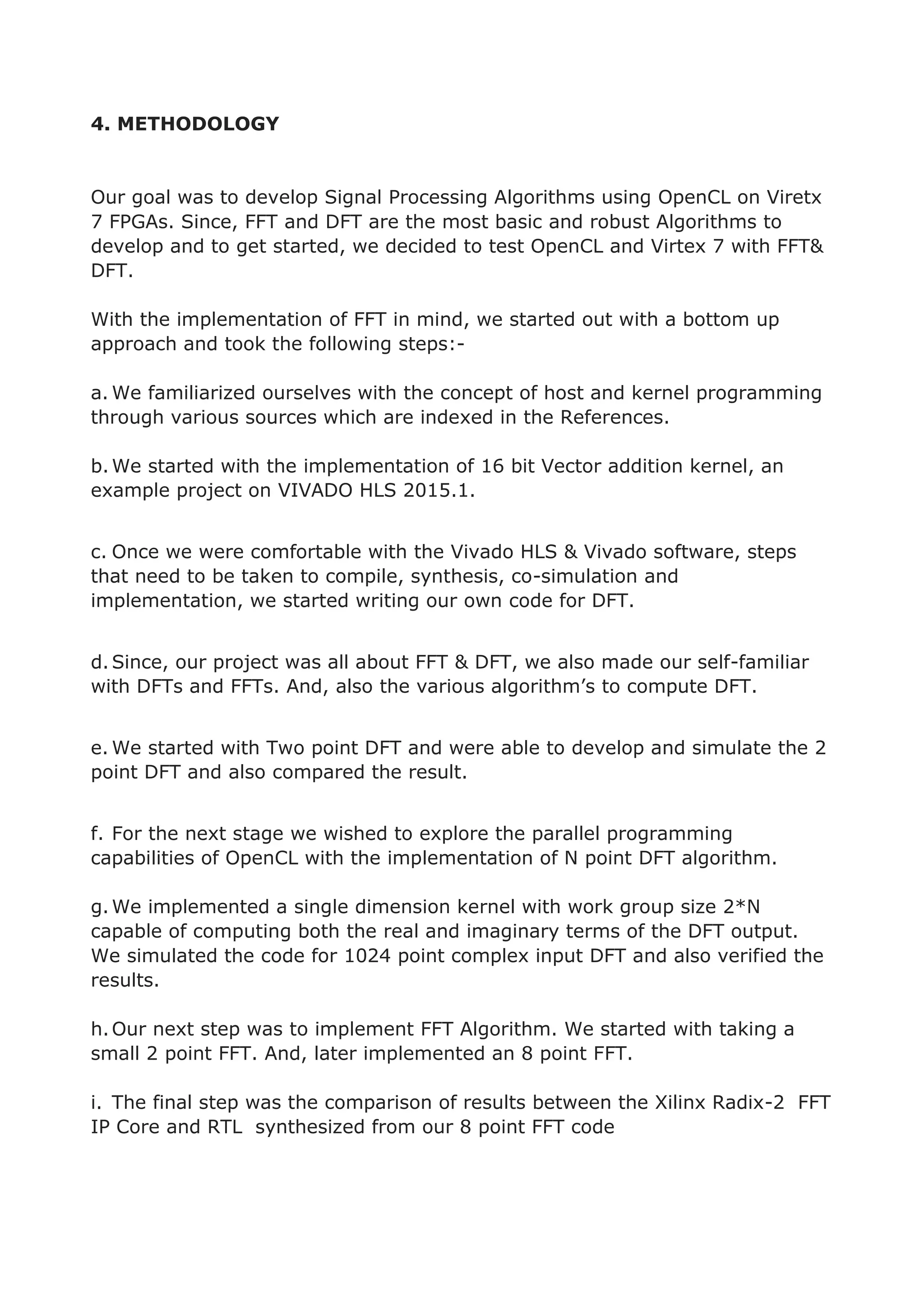
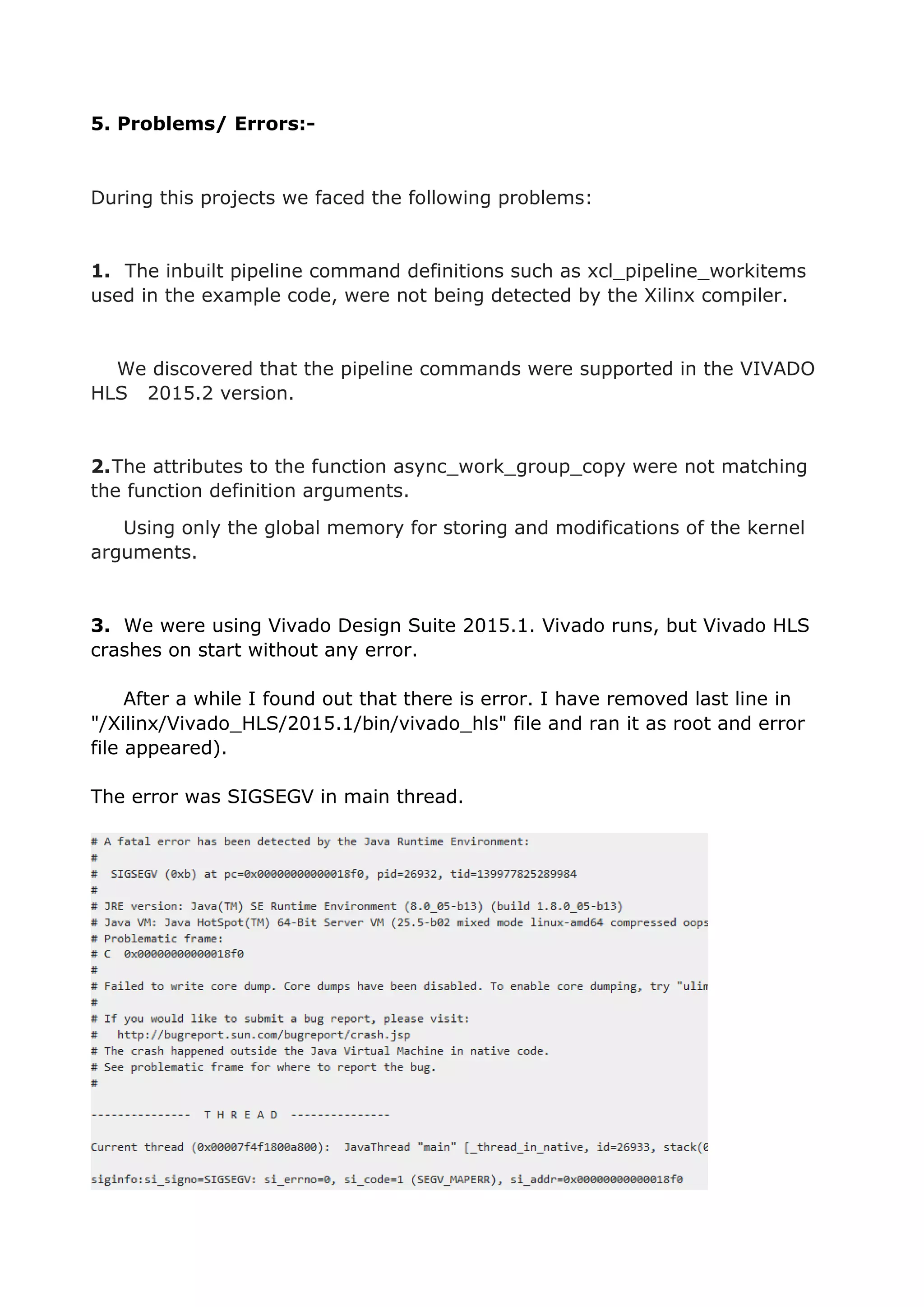

![Code in C:
Example 1, with no results what so ever.
int main ( )
{
int i, index, rev;
int NumBits;
for ( i=rev=0; i < NumBits; i++ )
{
rev = (rev << 1) | (index & 1);
index >>= 1;
}
return rev;
}
EXAMPLE 2:
We took another function below and after synthesis in Vivado_HLS it reports a
latency of 194 clock cycles and a utilization of 320 LUTS.
#define ROT32(x,n) ((x << n) | (x >> (32 - n)))
int main( )
{
long W[80];
int i;
//long temp, A, B, C, D, E, W[80];
for (i = 16; i < 80; ++i) {
W[i] = W[i-3] ^ W[i-8] ^ W[i-14] ^ W[i-16];
#ifdef USE_MODIFIED_SHA
W[i] = ROT32(W[i], 1);
#endif
//printf( "W[%i] = %li n", i, W[i]);
}
return 0;
}](https://image.slidesharecdn.com/c17fc98e-a864-4968-afb2-730eef728a11-160114020948/75/Development-of-Signal-Processing-Algorithms-using-OpenCL-for-FPGA-based-Architecture-28-2048.jpg)
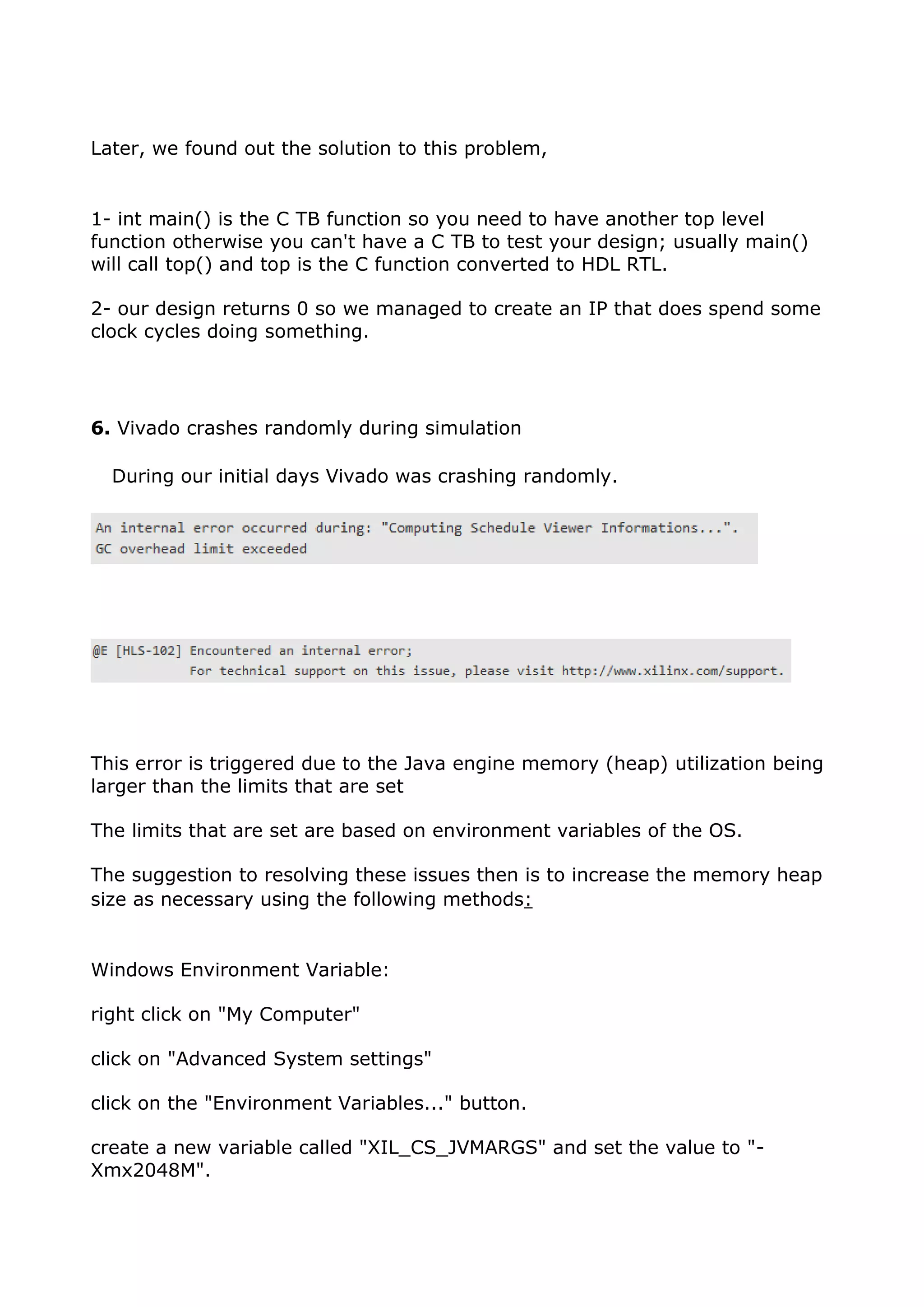

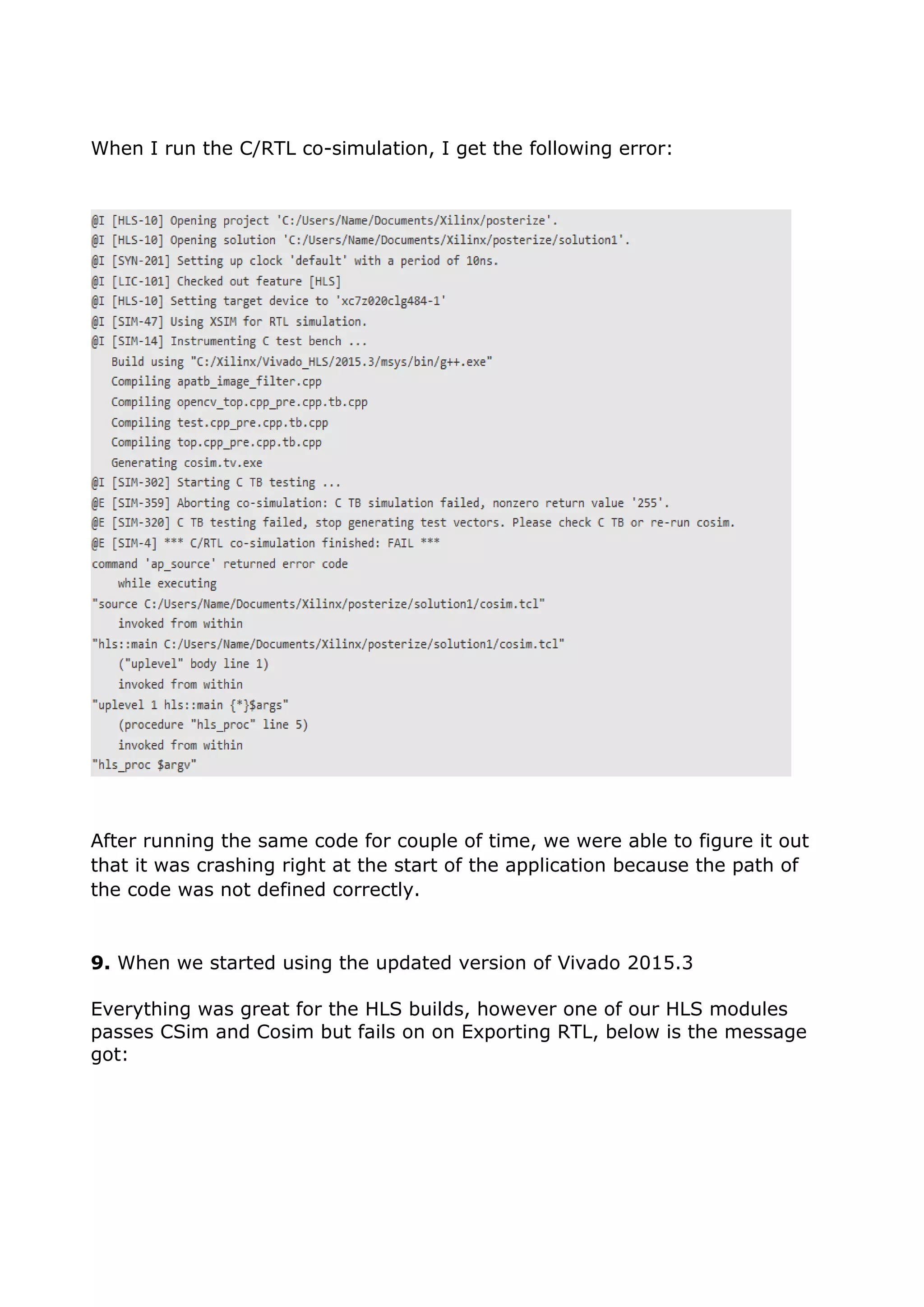

![6. PROGRAMMING USING VIVADO HLS
In the section that follows, all the OpenCL programs that were implemented
using the Xilinx Vivado HLS are briefly explained to present an understanding
of the Xilinx’s implementation of OpenCL.
6.1 Vector Addition
Out of the many example projects part of the Xilinx Vivado HLS, there is
only one example project that uses an OpenCL kernel. This example code
performs the basic vector addition operation. The host and the kernel code
are given below.
Host Code:
#include <stdio.h>
#include "vadd.h"
int main (int argc, char** argv)
{
int errors=0, i;
int a[LENGTH],b[LENGTH],hw_c[LENGTH],swref_c[LENGTH];
// Fill our data sets with pattern and compute their sum for reference.
for(i = 0; i < LENGTH; i++)
{
a[i] = i;
b[i] = i;
swref_c[i]= a[i] + b[i];
hw_c[i] = 0;
}
// Execute the OpenCL kernel function to allow C simulation
hls_run_kernel("vadd", a, LENGTH, b, LENGTH, hw_c, LENGTH );
// Verify the results match the pre-computed value
// Return a value of 0 if the results are correct (required for RTL
cosimulation)
for (i=0; i<LENGTH; i++)
{
int diff = hw_c[i] != swref_c[i];](https://image.slidesharecdn.com/c17fc98e-a864-4968-afb2-730eef728a11-160114020948/75/Development-of-Signal-Processing-Algorithms-using-OpenCL-for-FPGA-based-Architecture-33-2048.jpg)
![if(diff) {
printf("error - hw_c[%d]: %d differs from sw reference swref_c[%d]:
%dn",i, hw_c[i], i, swref_c[i]);
errors+=diff;
}
}
printf("There are %d error(s) -> test %sn", errors, errors ? "FAILED" :
"PASSED");
return errors;
}
Kernel Code:
#include <clc.h> // needed for OpenCL
kernels
#include "vadd.h" // header for this
example;
__kernel void __attribute__ ((reqd_work_group_size(LENGTH, 1, 1)))
vadd(__global int* a,
__global int* b,
__global int* c)
{
__local int a_local[LENGTH];
__local int b_local[LENGTH];
__attribute__((xcl_pipeline_workitems))
{
async_work_group_copy(a_local,a,LENGTH,0);
async_work_group_copy(b_local,b,LENGTH,0);
barrier(CLK_LOCAL_MEM_FENCE);
int idx = get_global_id(0);
c[idx] = a_local[idx] + b_local[idx];
}
}](https://image.slidesharecdn.com/c17fc98e-a864-4968-afb2-730eef728a11-160114020948/75/Development-of-Signal-Processing-Algorithms-using-OpenCL-for-FPGA-based-Architecture-34-2048.jpg)
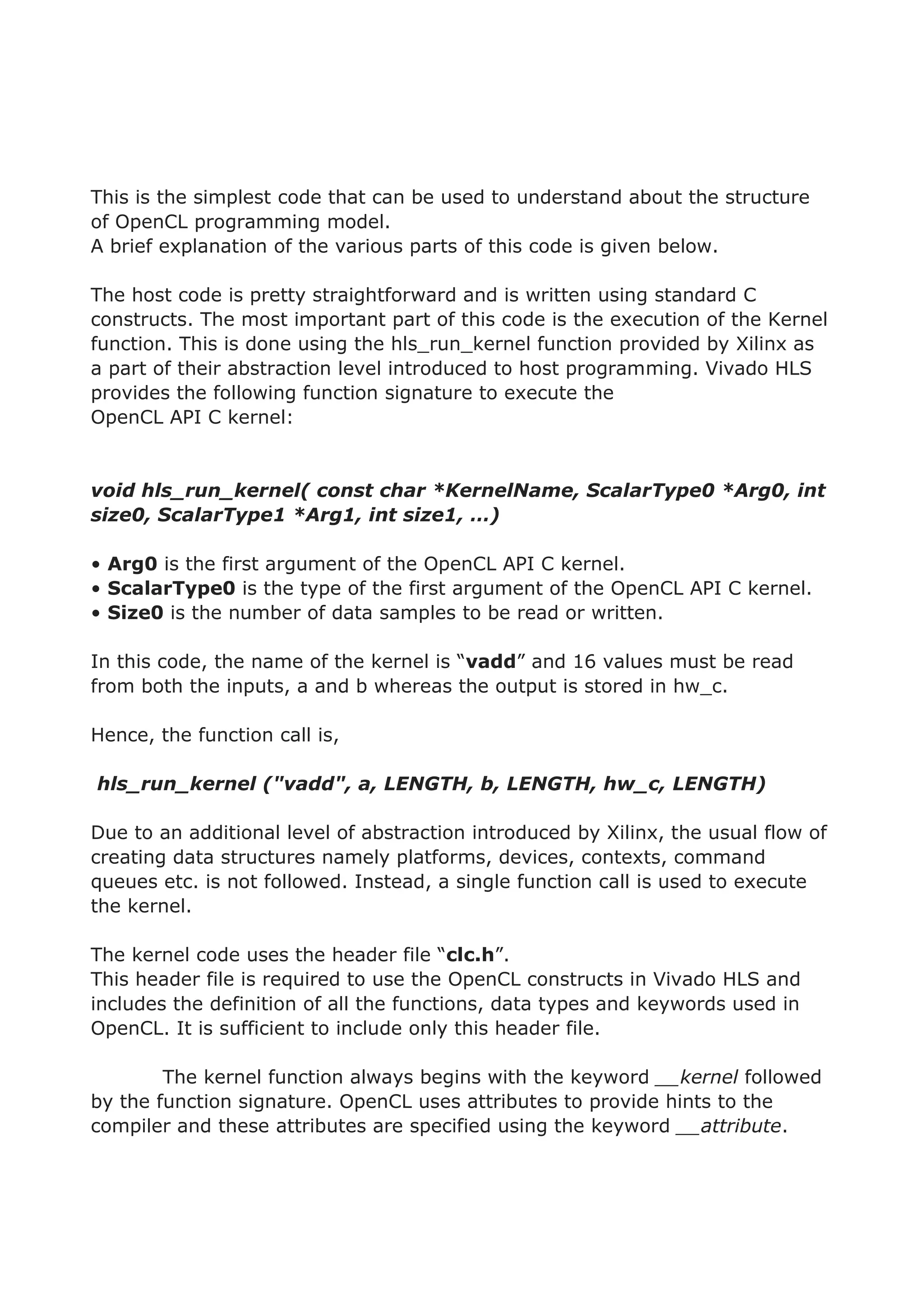
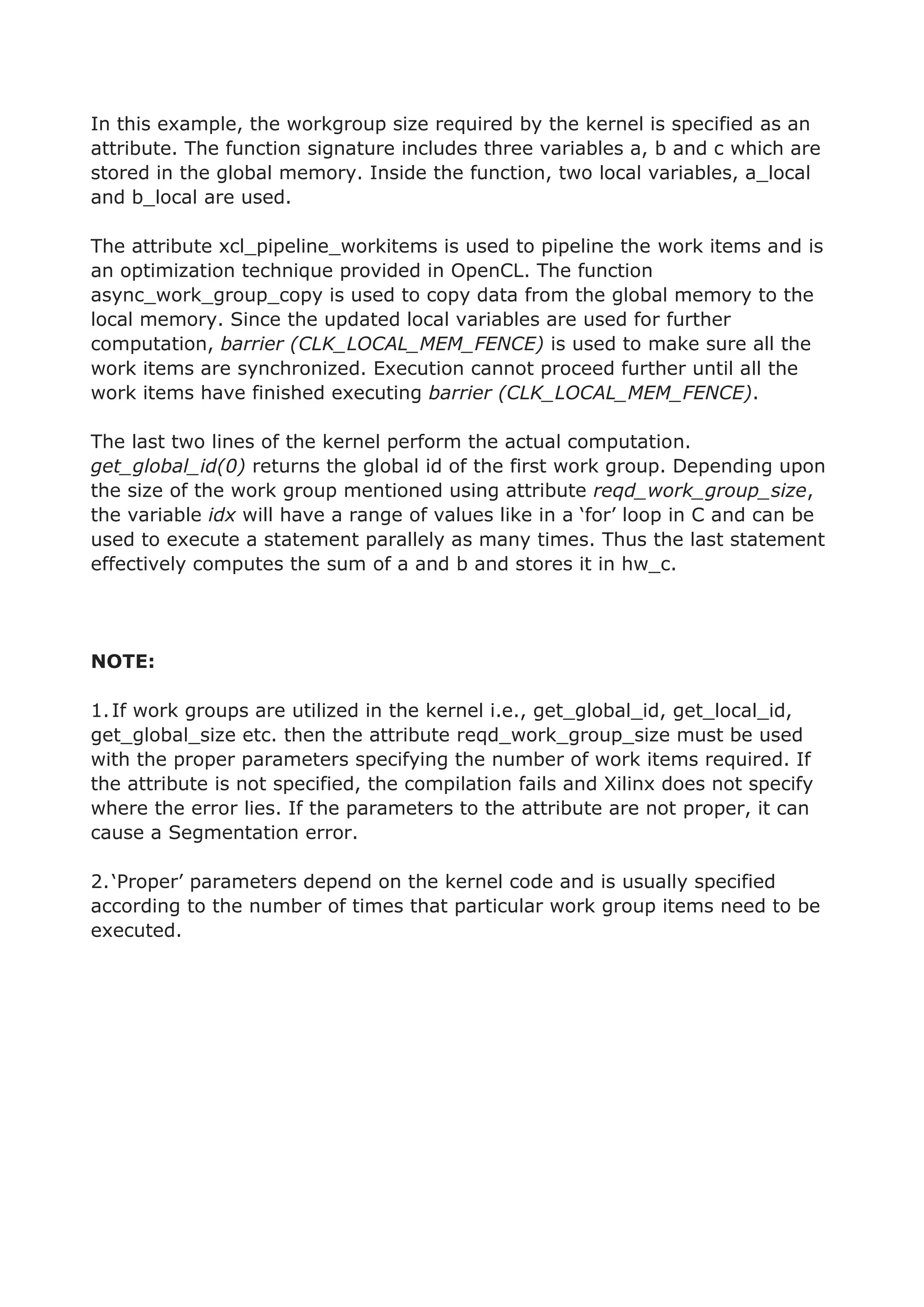
![6.2 8-Point FFT
Implementation of a FFT algorithm using OpenCL normally requires either
running multiple kernel functions or using recursion.
Since both these features are currently not supported on the Xilinx Vivado
HLS platform, the length of the FFT was chosen to be 8 (the least value
allowed by the built-in Xilinx FFT IP core) and the code was developed to use
a single kernel.
Host Code:
//8 point fft host code
#include<stdio.h>
#include <math.h>
int main()
{
int i,length=8,sign=1;
int twid[8]={0,0,0,0,0,0,0,0};//output
int x[8]={1,4,5,2,3,7,7,8};//input
int y[8]={0,0,0,0,0,0,0,0};
// Masking part. We wanted to mask 32 bit input, in such a manner
that we are taking on 8 bit at input.
int masking(int x[i] );
{ // Example value: 0x01020304
for (i=0; i<8 ; i++ )
{
int byte1 = (x[i] >> 24); // 0x01020304 >> 24 is 0x01 so
// no masking is necessary
int byte2 = (x[i] >> 16) & 0xff; // 0x01020304 >> 16 is 0x0102 so
// we must mask to get 0x02
int byte3 = (x[i] >> 8) & 0xff; // 0x01020304 >> 8 is 0x010203 so
// we must mask to get 0x03
int byte4 = x[i] & 0xff; // here we only mask, no shifting
// is necessary
y[i] = byte1;
}](https://image.slidesharecdn.com/c17fc98e-a864-4968-afb2-730eef728a11-160114020948/75/Development-of-Signal-Processing-Algorithms-using-OpenCL-for-FPGA-based-Architecture-37-2048.jpg)
![}
hls_run_kernel("fft",x,8,length,1,twid,8);
for(i=0;i<2*length;i++)
printf("%d /t %d n",x[i],twid[i]);
return 0;
}
}
In this host code, we have created a main function which take 8 bit fixed
point data as input. And, for output we have created an array which have zero
as its parameter.
Since, the input is 32 bits, we wanted to take only 8 bit data at the inputs we
have used masking for this purpose. In masking function we have use the
traditional technique of masking using AND, OR gates.
Following is the explanation of how we went about masking in our
Host Code:
A mask defines which bits you want to keep, and which bits you want to clear.
Masking is the act of applying a mask to a value. This is accomplished by
doing:
Bitwise ANDing in order to extract a subset of the bits in the value
Bitwise ORing in order to set a subset of the bits in the value
Bitwise XORing in order to toggle a subset of the bits in the value
Let’s say we want to extract some bits from higher no of bits, this is how we
can do this:
Below is an example of extracting a subset of the bits in the value:](https://image.slidesharecdn.com/c17fc98e-a864-4968-afb2-730eef728a11-160114020948/75/Development-of-Signal-Processing-Algorithms-using-OpenCL-for-FPGA-based-Architecture-38-2048.jpg)
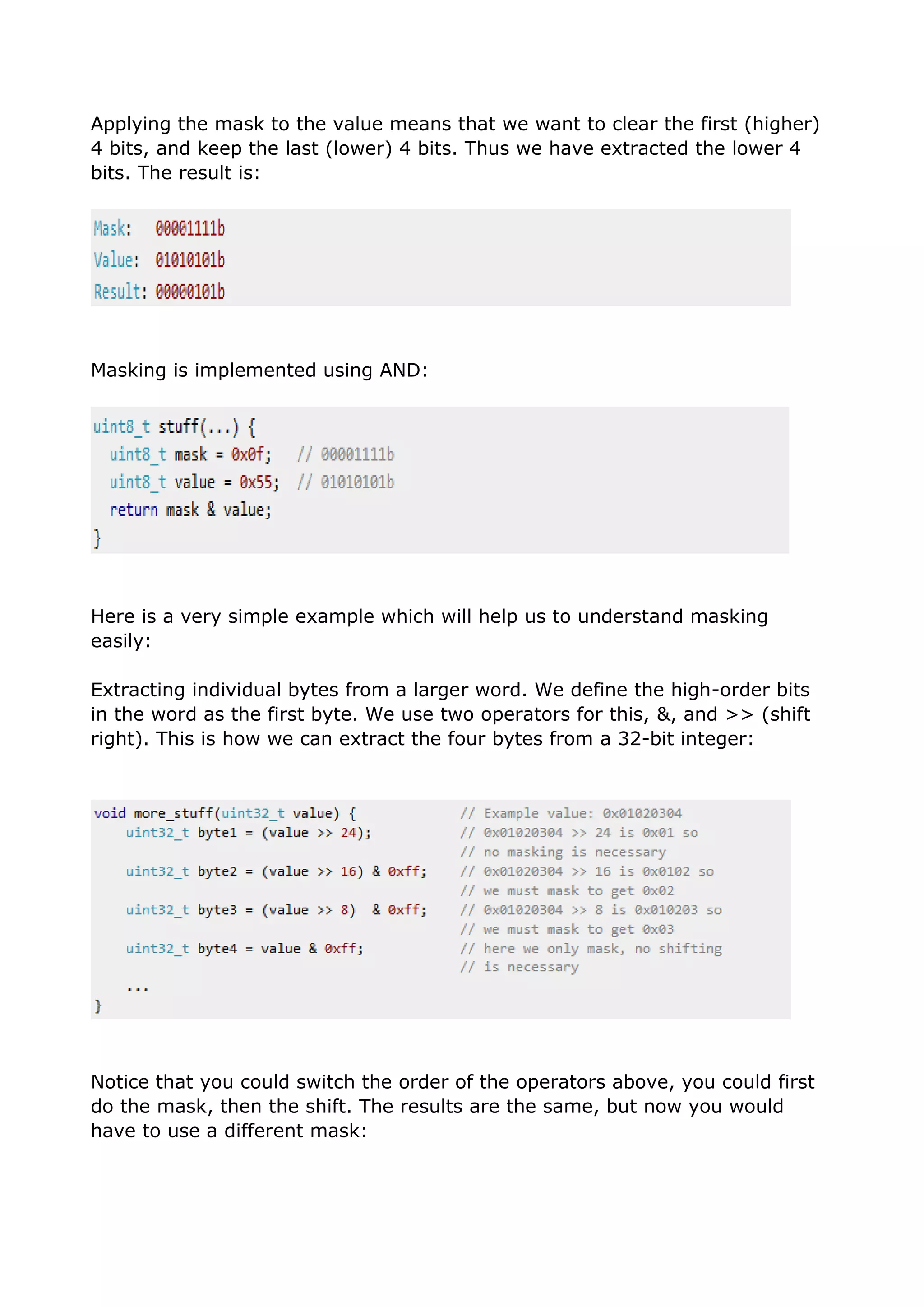
![Kernel Code: (for 8 point FFT)
//8 point fft kernel code
# include <clc.h>
__kernel __attribute__((reqd_work_group_size(1,2,2))) void fft(__global
float2* Y,int N,__global float2* Y3)
{
int i;
float2 twiddleFactors1[8];
float2 twiddleFactors2[8];
float2 Y1[8],Y2[8];
for( i= 0;i<N/2;i++)
{
Y1[2*i] = Y[2*i] + Y[2*i+1];
Y1[2*i+1] = Y[2*i] - Y[2*i+1];
}
int j = get_global_id(1);
Y1[2*j] = Y[2*j] + Y[2*j+1];
Y1[2*j+1] = Y[2*j] - Y[2*j+1];
float param1 = - 3.14159265359f * 2 * (2*j) / (float)N;
float c1, s1 = sincos(param1, &c1);
twiddleFactors1[2*j] = (float2)(c1, -s1);
twiddleFactors2[2*j] = (float2)(s1, c1);
float param2 = - 3.14159265359f * 2 * (2*j+1) / (float)N;
float c2, s2 = sincos(param2, &c2);
twiddleFactors1[2*j+1] = (float2)(c2, -s2);
twiddleFactors2[2*j+1] = (float2)(s2, c2);
for ( i=0; i<2; i++)
{
{](https://image.slidesharecdn.com/c17fc98e-a864-4968-afb2-730eef728a11-160114020948/75/Development-of-Signal-Processing-Algorithms-using-OpenCL-for-FPGA-based-Architecture-40-2048.jpg)
![Y2[j+i*N/2] = Y1[j+(i*4)] +
(float2)(dot(Y1[j+(i*4)+2],twiddleFactors1[2*j]),dot(Y1[j+(i*4)+2],twiddle
Factors2[2*j]));
Y2[j+2+i*N/2] = Y1[j+(i*4)] -
(float2)(dot(Y1[j+(i*4)+2],twiddleFactors1[2*j]),dot(Y1[j+(i*4)+2],twiddle
Factors2[2*j]));
}
}
{
int m = get_global_id(2);
for ( i=0; i<2; i++)
{
{
Y3[m+i*2] = Y2[m+i*2] +
(float2)(dot(Y2[m+i*2+4],twiddleFactors1[m+i*2]),dot(Y2[m+i*2+4],twidd
leFactors2[m+i*2]));
Y3[m+i*2+4] = Y2[m+i*2] -
(float2)(dot(Y2[m+i*2+4],twiddleFactors1[m+i*2]),dot(Y2[m+i*2+4],twidd
leFactors2[m+i*2]));
}
}
}
}
In this code, the kernel makes use of three work groups with sizes 1,2,2
respectively.
Each work group is used to perform exactly one stage of the 8-Point FFT.
Vector operations are used to compute both real and imaginary values
together.
The first stage uses get_global_id(0);
The second stage uses get_global_id(1);
The third stage uses get_global_id(2).
The work items in each work group execute parallely.
All the three programs were successfully simulated and synthesized to obtain
the RTL codes using the Xilinx Vivado HLS.](https://image.slidesharecdn.com/c17fc98e-a864-4968-afb2-730eef728a11-160114020948/75/Development-of-Signal-Processing-Algorithms-using-OpenCL-for-FPGA-based-Architecture-41-2048.jpg)
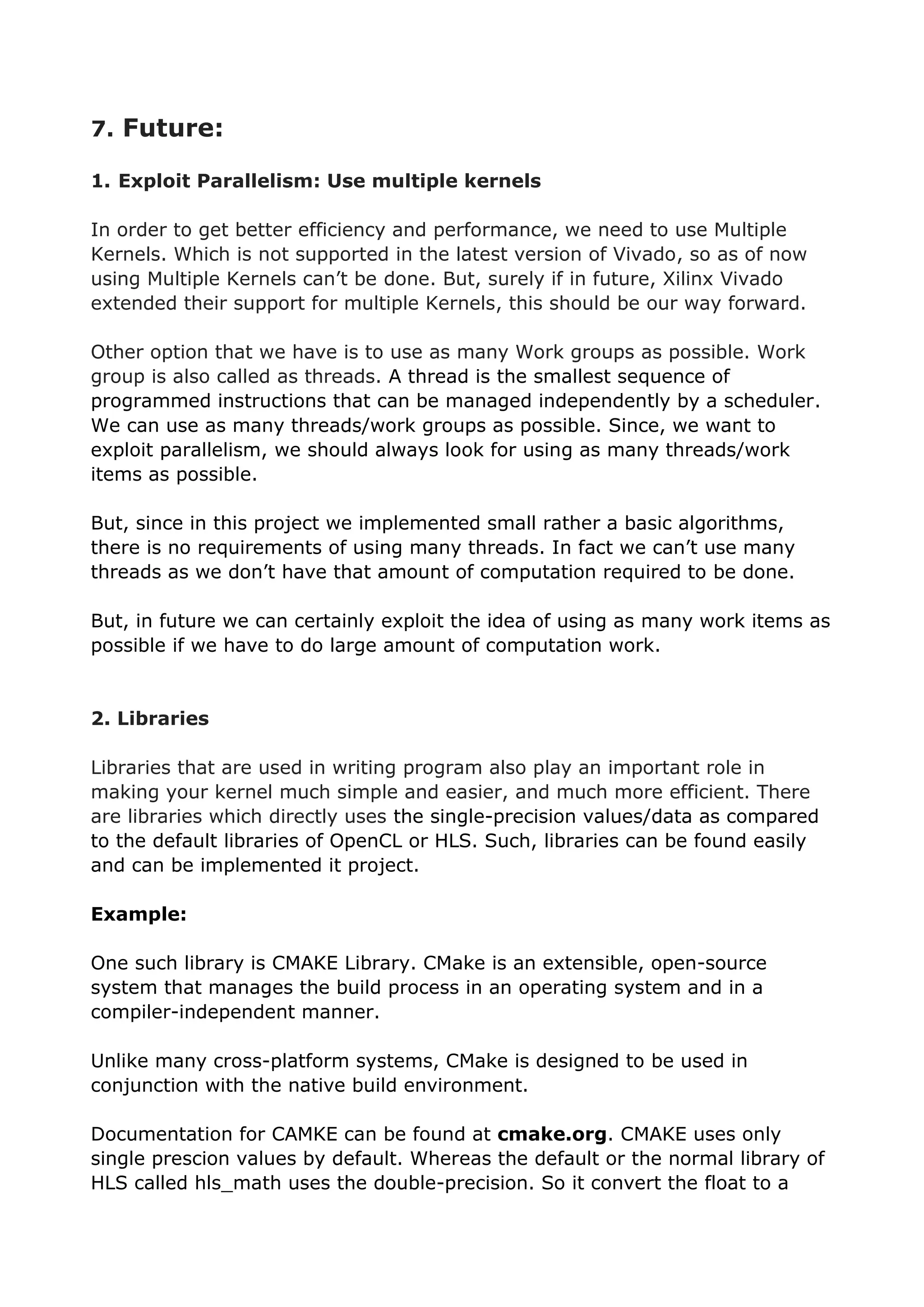
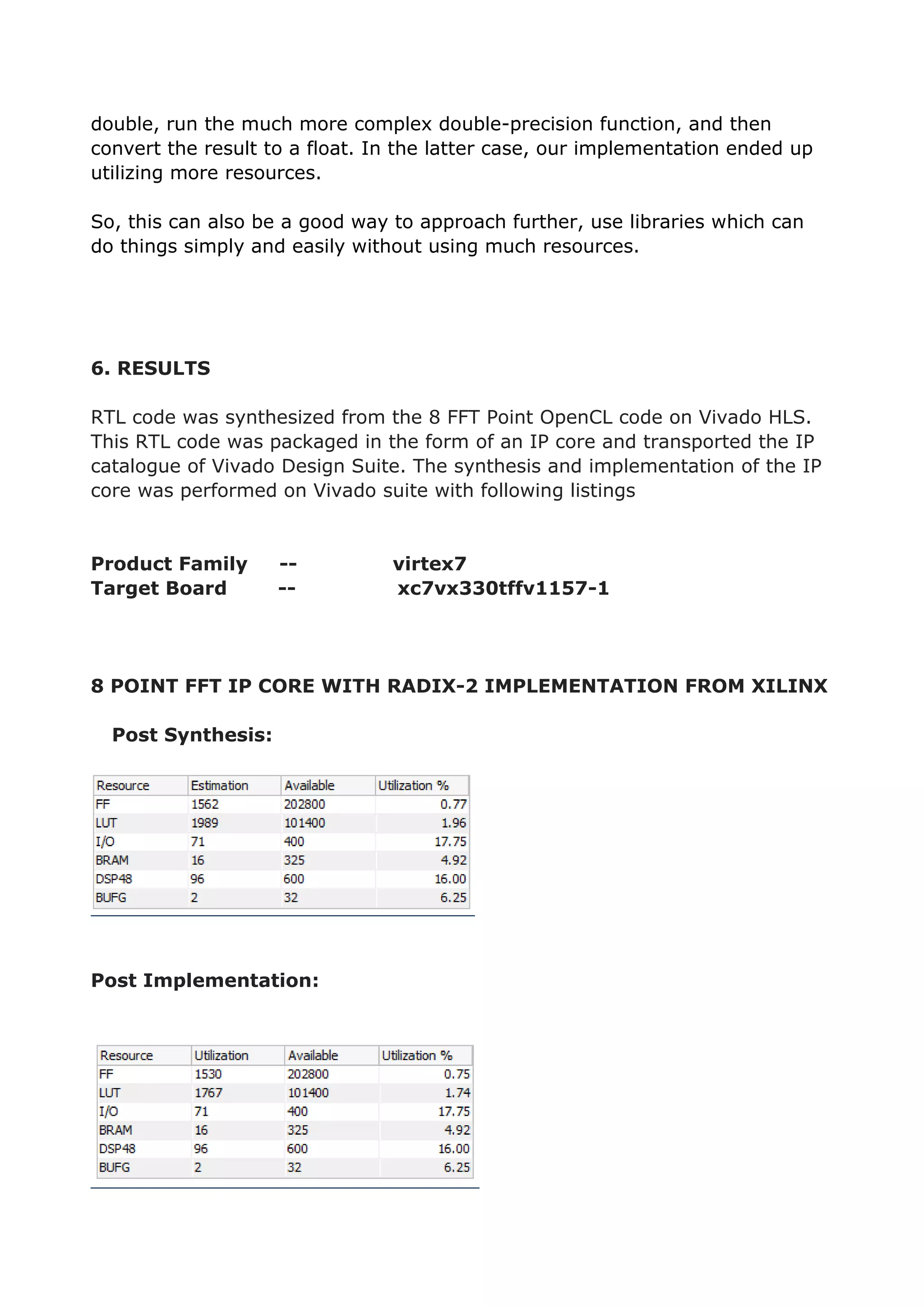
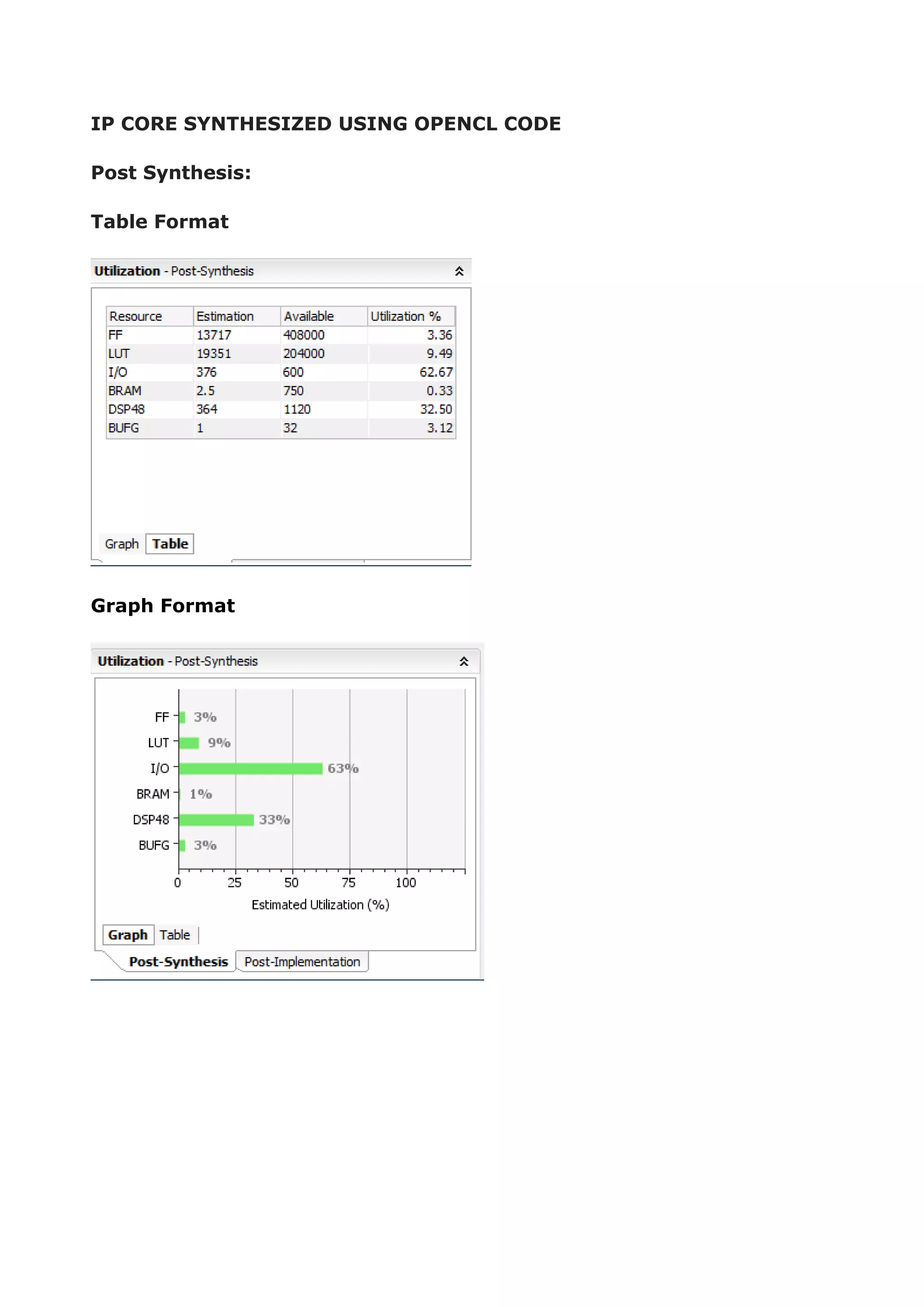
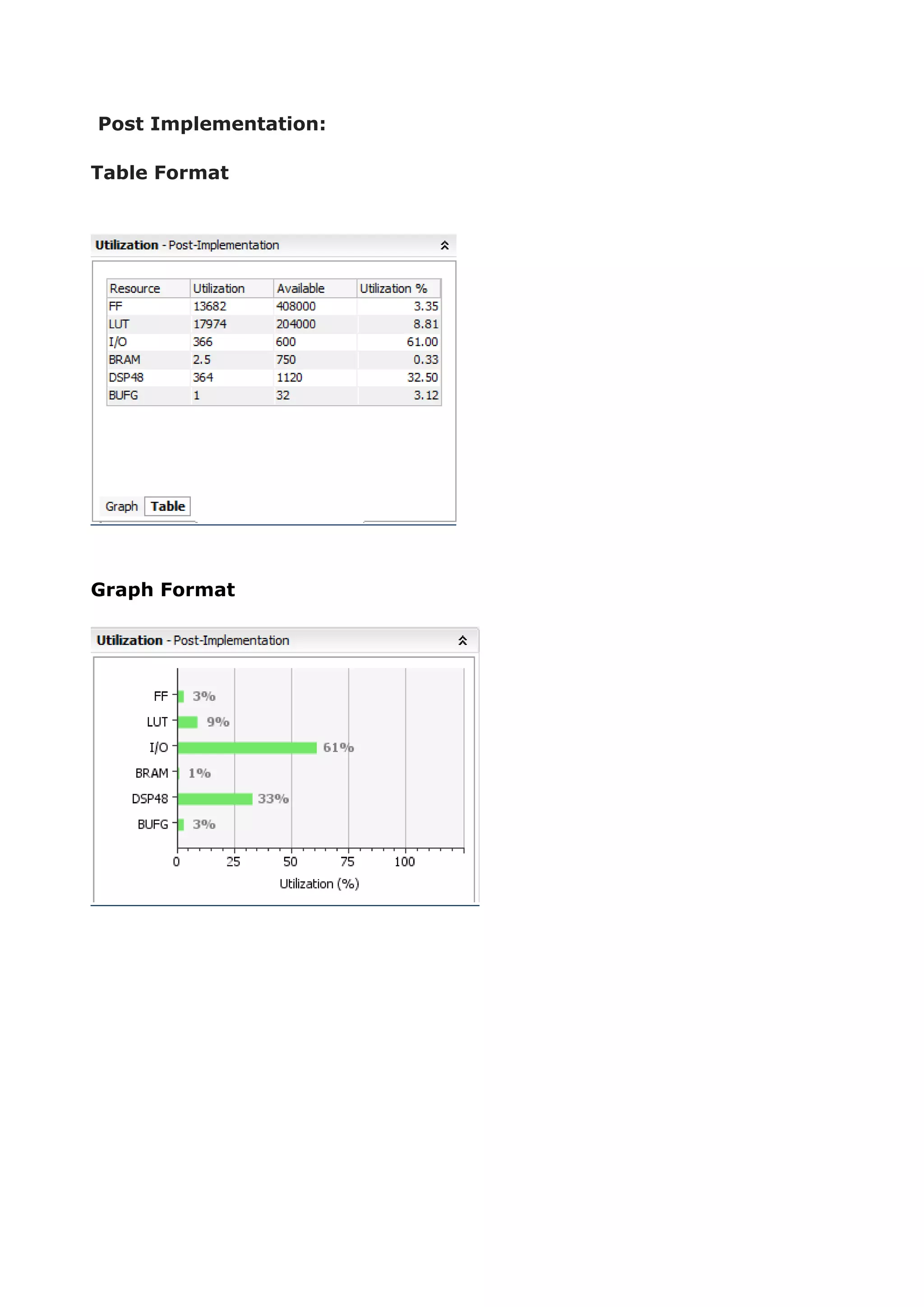
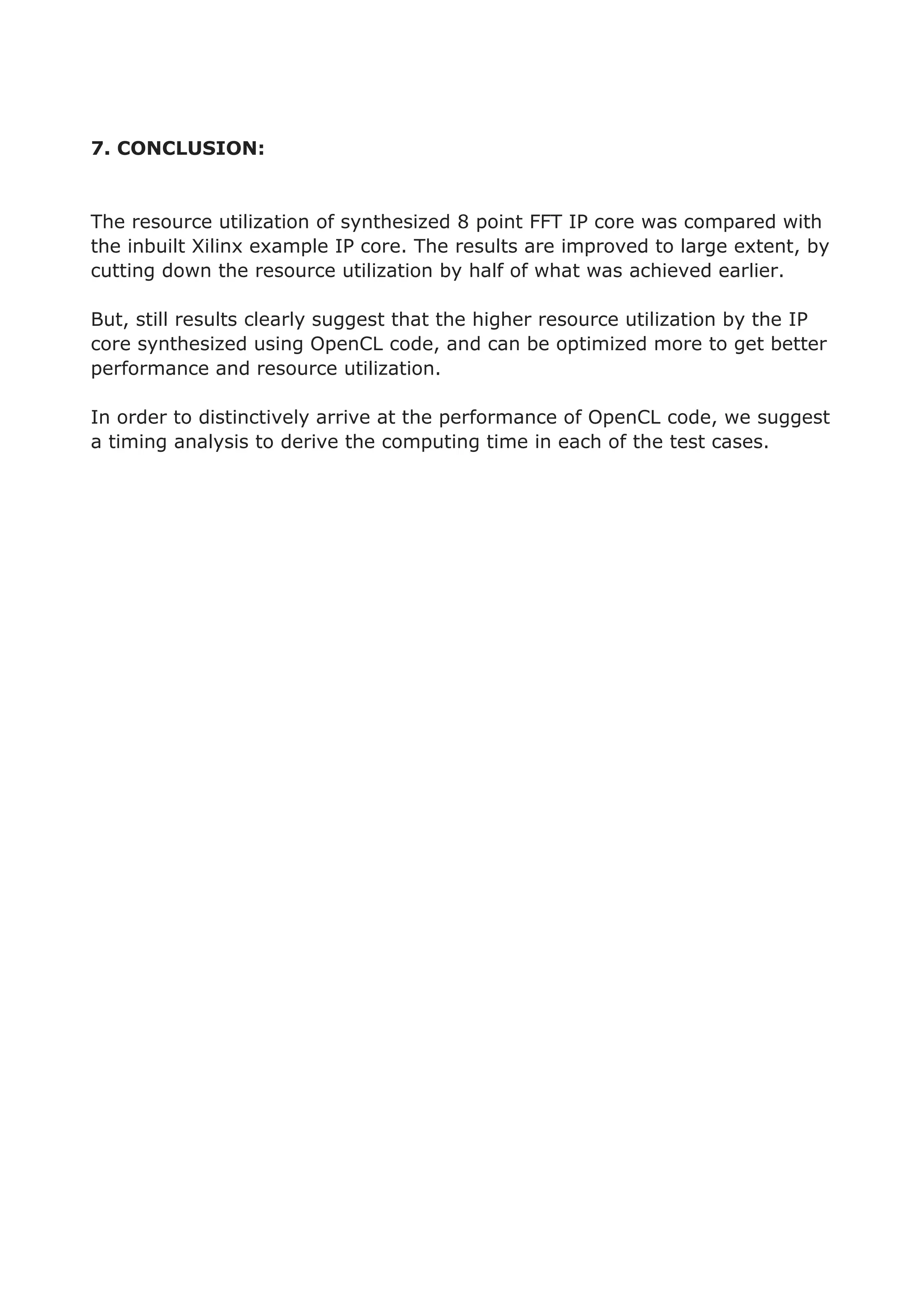
![8. REFERENCES
[1] Mathew Scarpino, “OpenCL In Action: How to accelerate graphics and
computation”, Manning Publications Co., ISBN: 9781617290176
[2] OpenCL on Khronos Group - https://www.khronos.org/opencl/
[3] OpenCL Reference Page on Khronos Group -
https://www.khronos.org/registry/cl/sdk/1.1/docs/man/xhtml/
[4] OpenCL 1.0 API and C Language Specification (revision 48, October 6,
2009)
[5] UG-902 Vivado Design Suite User Guide - High-Level Synthesis
[6] Xilinx SDAccel: A Unified Development Environment for Tomorrow’s Data
Center
[7] OpenCL Reference Page on Stream Computing Group -
http://streamcomputing.eu/consultancy/by-technology/opencl/](https://image.slidesharecdn.com/c17fc98e-a864-4968-afb2-730eef728a11-160114020948/75/Development-of-Signal-Processing-Algorithms-using-OpenCL-for-FPGA-based-Architecture-47-2048.jpg)